Clocks have been used since the beginning of time and in many different forms. Sundials are the earliest known type of timepiece made by man.
Since then, clocks have become smaller, in the form of watches, and more sophisticated. There are now many different types to choose from to meet a variety of timing needs. Check out this vast array of clocks.
By Style:
Automaton Clock

An automaton clock is a striking clock with automatons. The automaton would work the clock automatically in a specific order.
This type of clock was widely available during the 1st century BC to the Victorian era. A basic form is the cuckoo clock.
This clock tower features two figures at the top that move along with the clock.
Balloon Clock
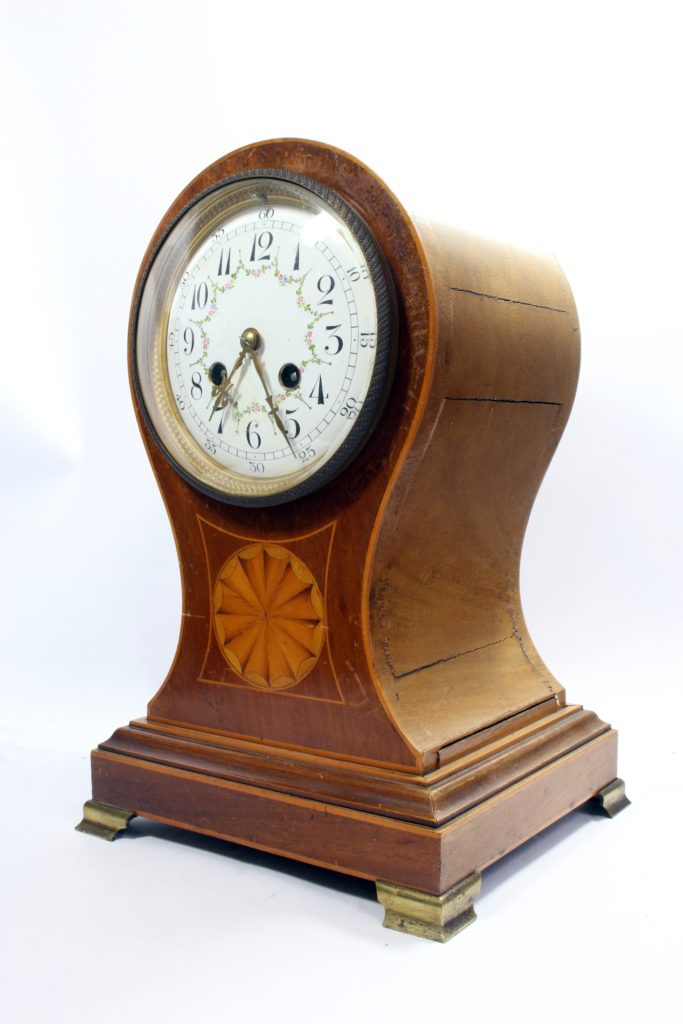
A balloon clock is a type of bracket clock that can sit on a table as a décor piece and to tell the time throughout the day. The case is shaped in a balloon or waste, with a tapered part just under the clock, widening near the bottom.
The balloon clock was popular in the late 18th to early 19th century in England. The balloon clock was likely based on French clocks that are made of a specific type of wood, such mahogany or satinwood.
Banjo Clock
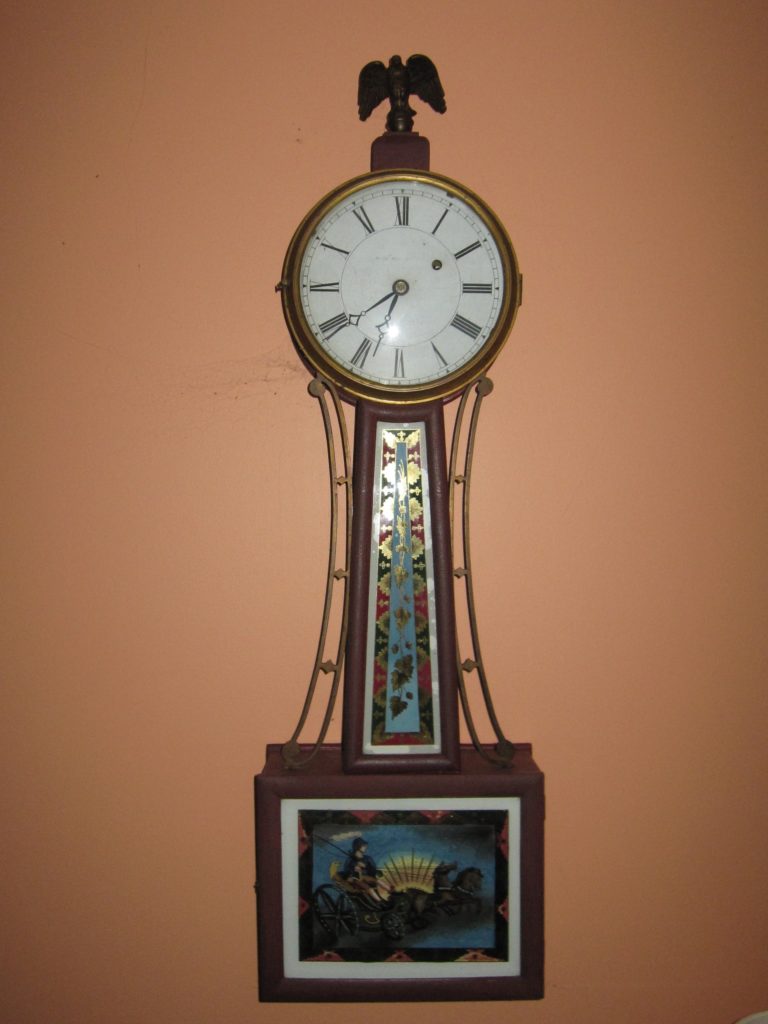
A banjo clock is a wall clock made in the United States that has a case in the shape of a banjo. Simon Willard invented the banjo clock in Grafton, Massachusetts in 1802.
Unlike a grandfather clock, the banjo clock does not have a striking mechanism and tells the time with hands and a dial. The face of the clock can be seen in the round part at the top. The throat is long with a pendulum that is in the shape of a box.
Bracket Clock
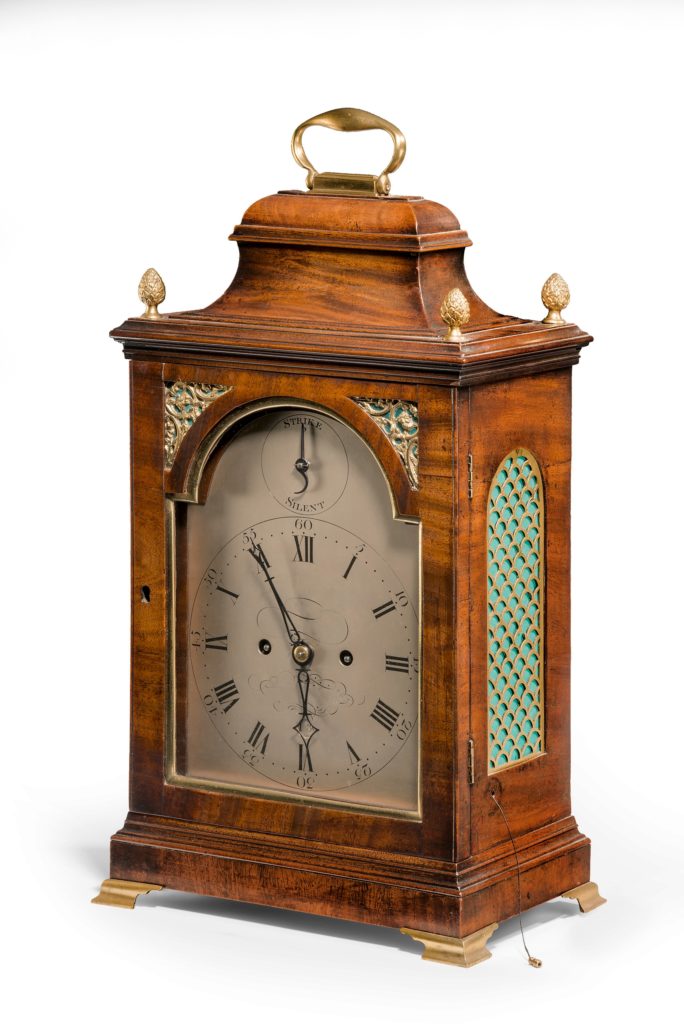
A bracket clock is a portable table clock that was made in the 17th and 18th centuries. The device includes a clock attached to a decorative shelf made small for its size. These clocks were made of ebony and wood, with decorative parts in brass, wood, and varnish.
They were called bracket due to pendulum clocks that needed to be placed on a bracket on a wall so that the weights could hang down. These timed devices can repeat the striking of hours when their cord or lever was pulled.
Carriage Clock

A carriage clock is a small clock made to travel with. It was created in France in the early 19th century and they were referred to as “Officers’ Clocks”.
The first of these spring-driven timed devices were made by Abraham-Louis Breguet. He made these in 1812 for Emperor Napoleon.
The case was shaped like a rectangle that had a handle. The clock had a glass cover with the case made in gilt-brass or plain.
Cartel Clock
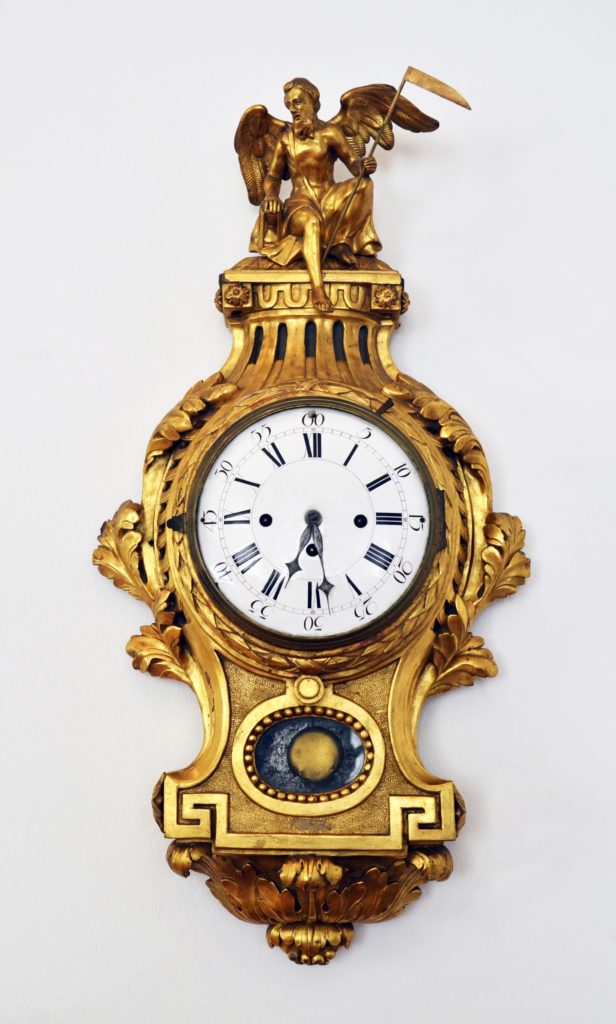
A cartel clock was a highly designed mechanism that hung in the walls of homes in the 1700s. Many had floral designs around the face of the clock. These were popular in Paris and other parts of France.
Many were made of gilt bronze, which is a specific type of gilding style. As time went on, less styled versions were more desired than the highly-detailed original ones.
Henri-Charles Balthazar was a well-known clockmaker who was a master in 1717. He was from a family of clockmakers and made the one featured in the photograph.
Kit-Cat Klock
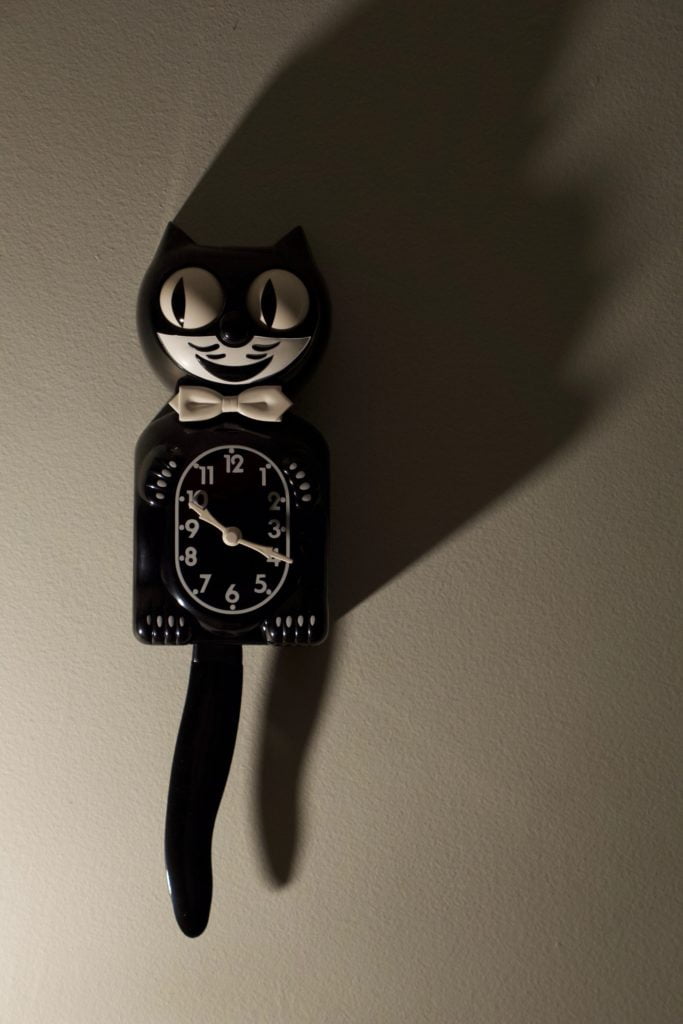
The Kit-Cat Klock is a clock made in 1932 and is still popular today. This wall clock has a head in the shape of a cat with pointy ears above the face of the clock. His body and arms surround the timing device, with the tail moving from side to side to keep time.
This iconic American-made clock was created by Earl Arnault, who was a designer based in Oregon. The earlier-made timepieces were made with metal bodies. When plastic molding became popular, the pendulum clocks were soon made with plastic.
These cat clocks are still popular today and can be ordered in all kinds of colors.
Chariot Clock
The chariot clock gets its name from looking like a chariot. The dial part of the clock would be built in the wheel or other part of the chariot. These started showing up in southern Germany in the latter part of the 16th century.
Some of these clocks included ones with automaton, such as the one in the picture. Diana, the goddess of the hunt and Moon, rides on a chariot pulled by two leopards.
The clock’s case is made with gilded bronze and ebony. The dials are made of partially enameled silver and iron and brass for the moveable parts.
Clock Tower

A clock tower is a clock set at the top of a tower, such as the famous Big Ben clock tower in London, England. The device usually is a turret clock with one or more faces that can be seen on the outside walls.
Clock towers have been around since antiquity. Since the majority of people did not have watches at this time, they would rely on the device telling time on the tower throughout the day.
The earliest-known one was one in Athens called the Tower of the Winds, which had eight sundials.
Floral Clock

A floral clock is a clock that is formed with flowers and other plants. These clocks are usually in a public place, such as a park. The mechanical parts of the clock are placed in the ground under the flowerbed.
John McHattle, the Superintendent of Parks in Edinburgh, Scotland came up with the idea. The first floral clock was planted in 1903 at the West Princes Street Gardens. Soon, these clocks started sprouting up all over the world.
A variety of flowers, succulents, and other plants can be planted in specific areas to indicate the hours.
Grandfather Clock
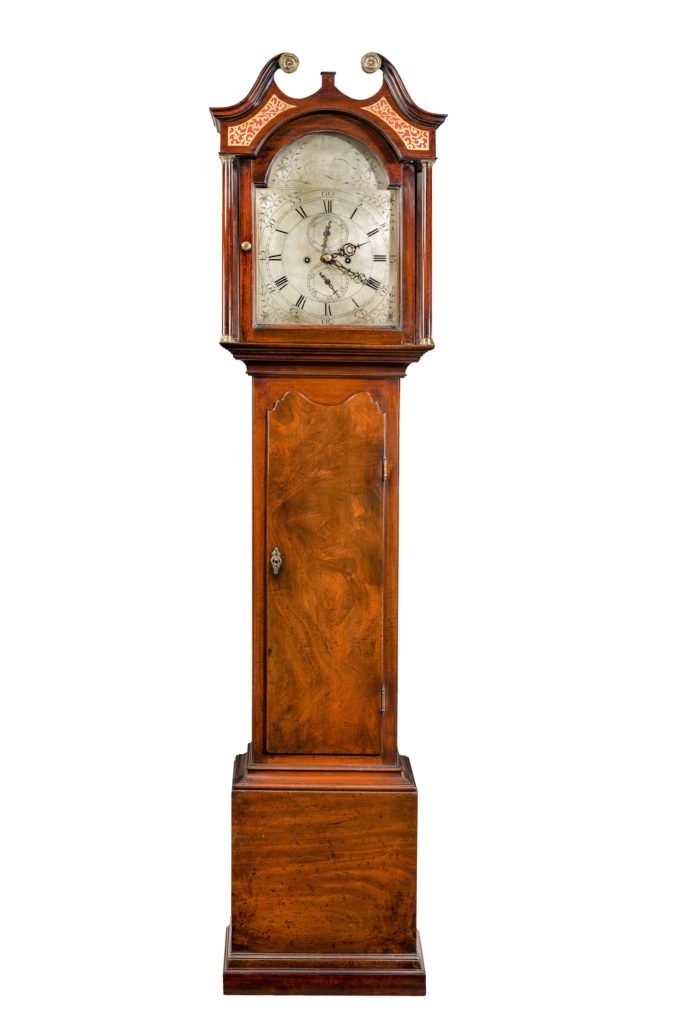
A grandfather clock is also referred to as a longcase clock or tall pendulum clock, due to the large case and pendulum that is included. These stand on the floor and are 6 to 7.5 feet tall, or 1.8 to 2.3 meters tall.
Henry Clay Work wrote a song called “Grandfather’s Clock” in 1876, which gave the clock its famous nickname. These clocks are still popular today and come in a variety of styles.
The face is located at the top, with the pendulum in a closed case with or without a glass door.
Lantern Clock

A lantern clock is a clock made in the shape of a lantern. It can also be from the word “latten”, a term used for brass in the 17th century, when these clocks were first made.
England gets credit for the origins of this timed piece. The first versions only had an hour hand and were made to hang on a wall.
They are also considered to be the first clocks used in homes. These clocks were soon replaced by others in the 19th century.
Mantel Clock
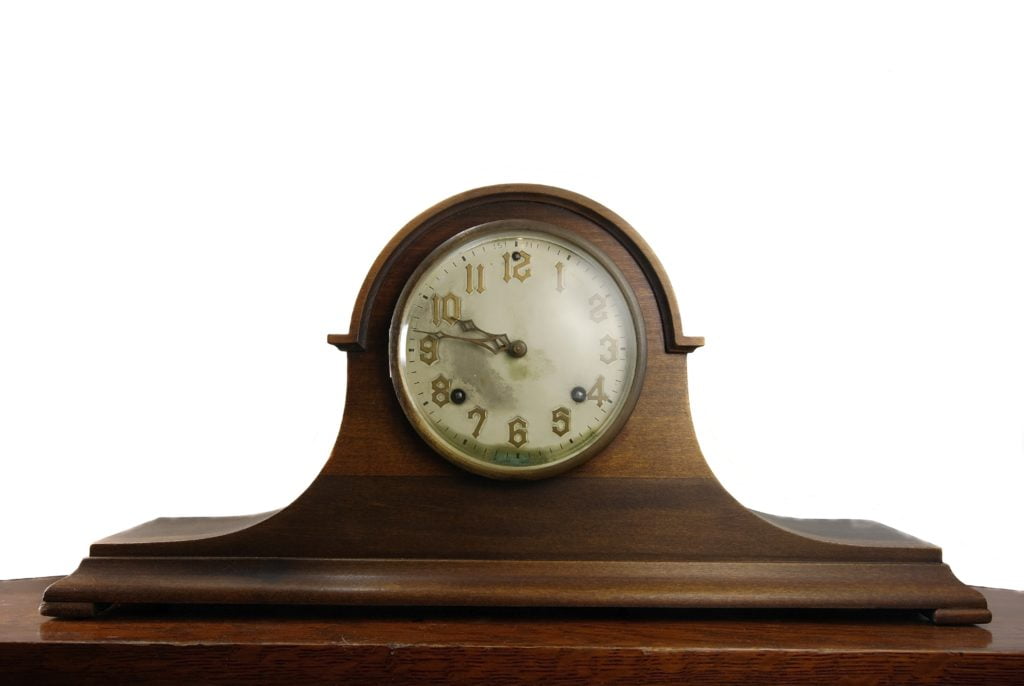
A mantel clock is a small clock used in the house, specifically made to sit on a shelf, such as a mantel, above the fireplace. They were first made in France in the 1750s.
The first version of these timed instruments was very decorative, made with porcelain, ormolu, and wood. Simon Willard made an economical version in Boston, Massachusetts in the 19th century.
Both the ornate and economical versions of the mantel clock were popular during their time. Willard’s versions sell for $50,000 to $250,000.
Skeleton Clock
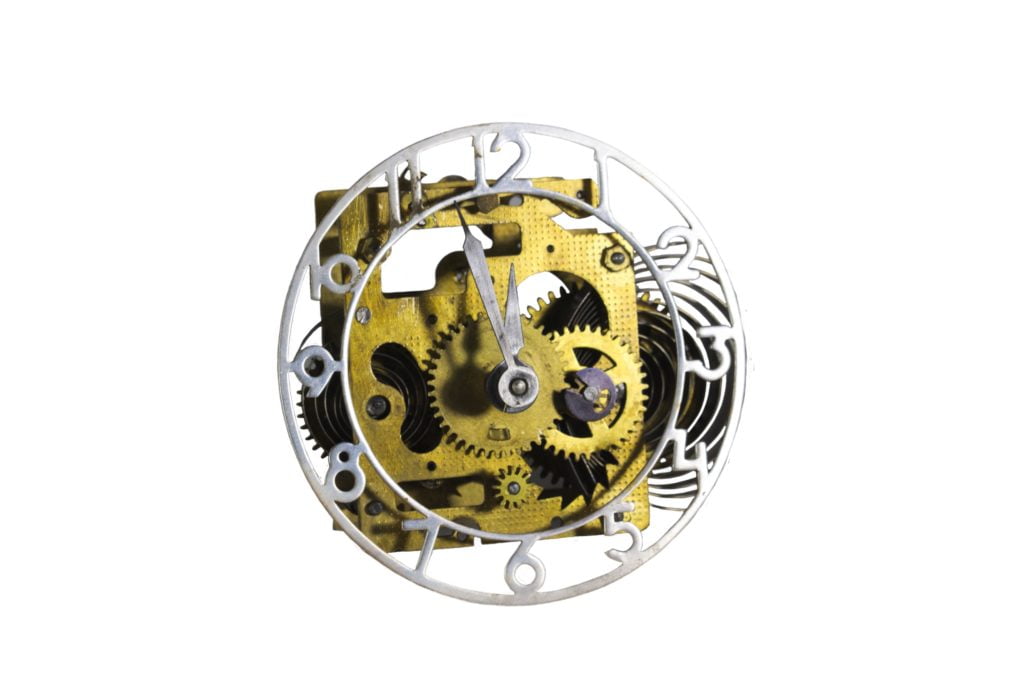
A skeleton clock is any wristwatch or clock where the inner mechanisms can be seen from the outside. The wheels, gears, and springs can be seen moving while the watch tells time.
Certain mechanical features are made to stand out on a skeleton clock. These can include mainspring, escapement, tourbillion, balance wheel and balance spring.
The dial can be seen as a ring, is clear, or not included. Wall versions of these clocks are mass-produced, while the more expensive ones are handmade out of wrought iron or wood.
Watch
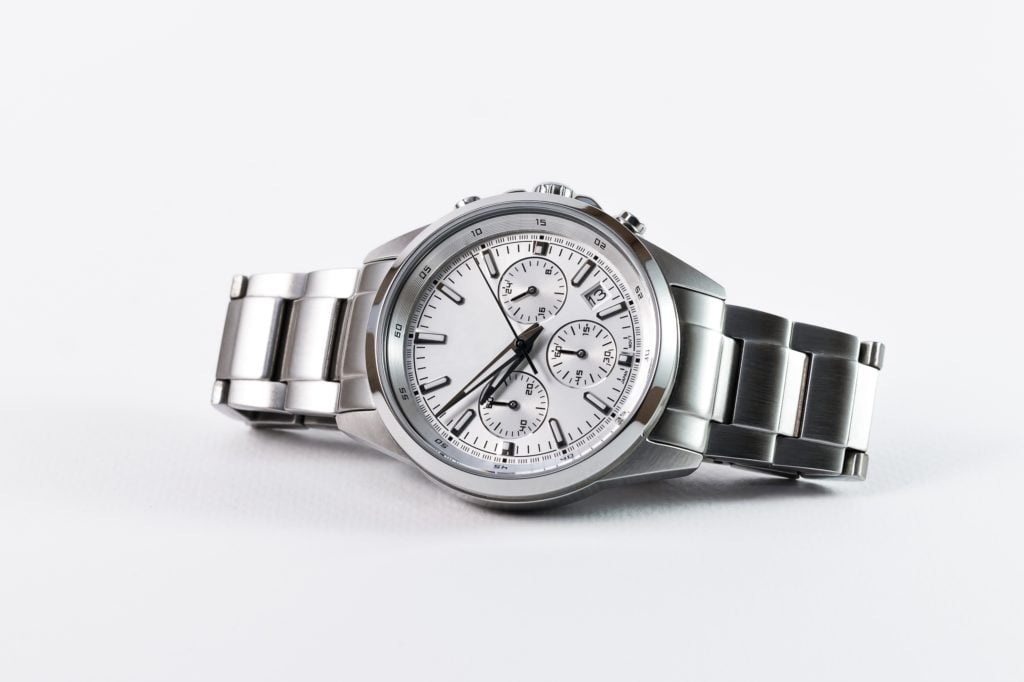
A watch is a small clock worn around the wrist or kept in a pocket. It moves with either electricity or a spring. They were first made soon after 1500 by Peter Henlein, who was a locksmith in Nurnberg, Germany.
Early versions of the watch were worn around the neck on a chain or carried by hand. The self-winding pocket watch was first patented in 1780 in London.
Electronic watches first came onto the scene in 1953, with smartwatches the latest version of these small timely devices.
Wall Clock

A wall clock is simply a clock made to hang on a wall. They come in a variety of styles, colors, shapes, and designs.
Peter Henlein of Germany is credited to inventing the first modern mechanical clock, which are very close to the clocks we use today.
A wall clock has a hole to hang from a wall. These clocks can look basic, or decorative with plenty of design elements.
The clock in the photograph has a black face with white numbers and hands. It is plain but functional.
Outdoor Clock
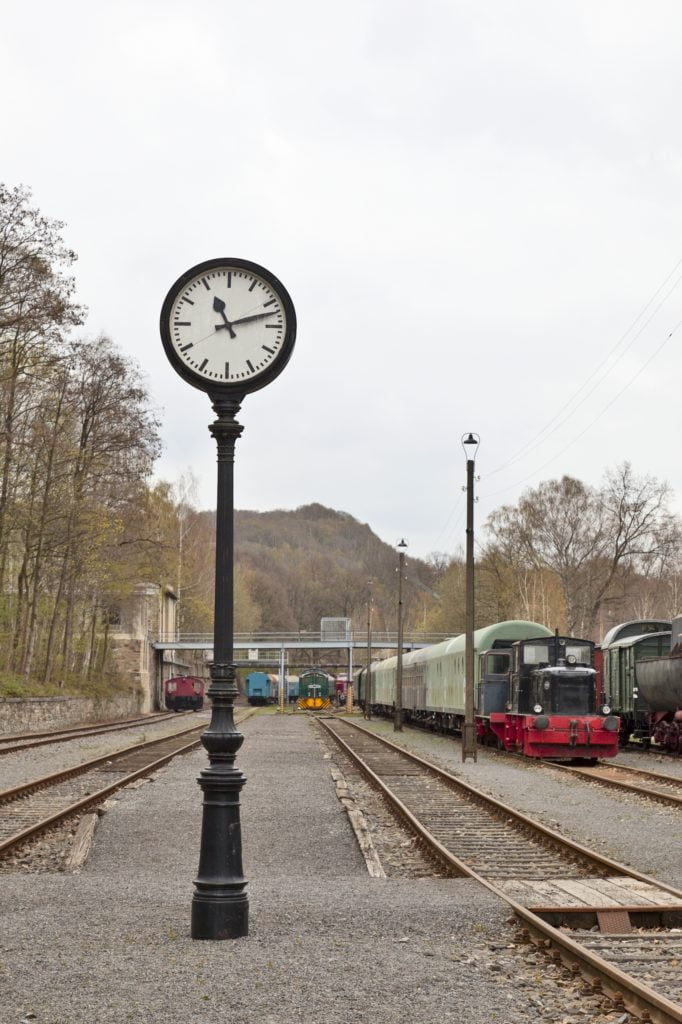
An outdoor clock is a clock designed to be used outside. Outdoor clocks can stand on their own on a post, hang from a wall, or be placed on a building so that many people can see it.
The clock in the picture is located a train station. It is located between two tracks so that conductors and passengers can know what time it is when they leave or arrive at the station.
The clock has a plain, white face with black hands and marks indicating the hour and minutes.
Floor Clock
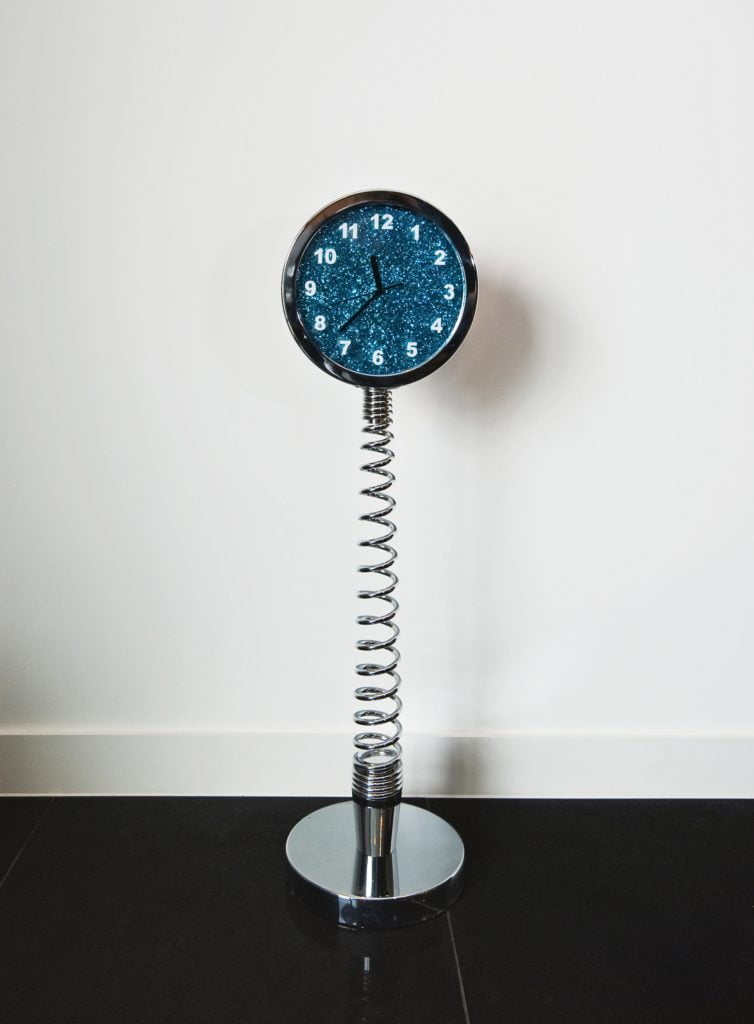
A floor clock is a timepiece that is built on a stand to be placed on the ground. The face of the clock is located at the top of the stand. A popular type is the grandfather clock.
These types of clocks have been around for hundreds of years. Modern floor clocks come in a variety of styles and designs.
This modern floor clock in the picture is supported by a spring with a flat base on the floor. The face is designed with a blue background.
Clock with Roman Numerals

It used to be popular to have clocks with Roman numerals. Today, you can find clocks with both Arabic and Roman numerals.
This clock has “IIII” as the four, although “IV” has been used as the number four since the ancient Roman era. Both versions of the Roman four are still seen on clocks today.
The clock in the picture is an antique that uses “IIII” to represent “four” on the clock. There are small, floral designs between each number, with decorative hands and a brass or gold border.
Antique
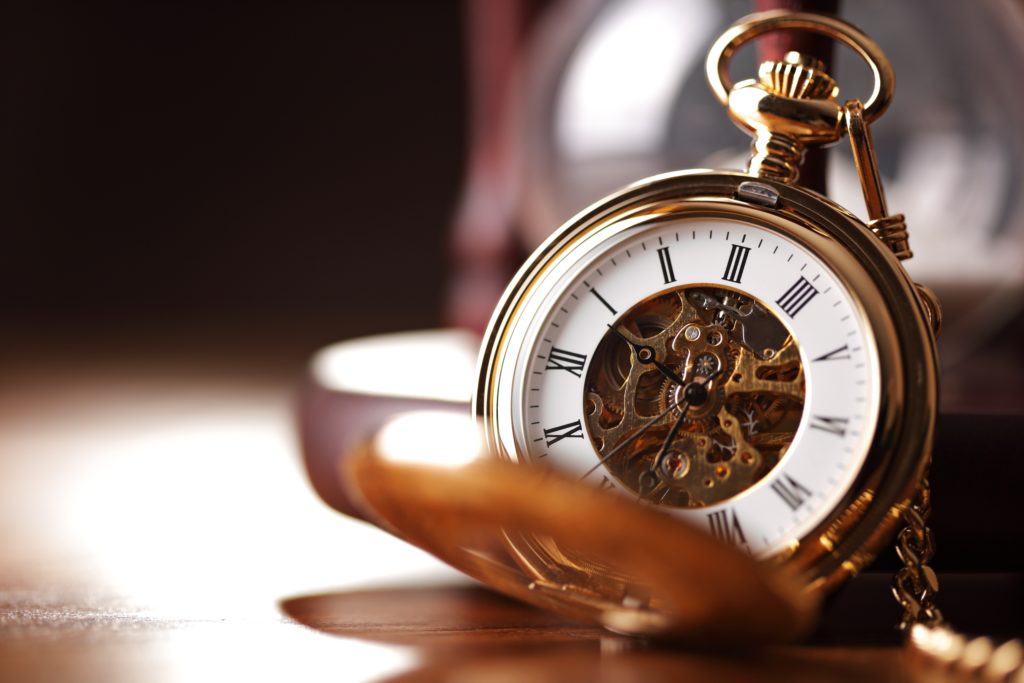
An antique clock is a work of art that also functions as a timepiece. These can be worth a lot of money, based on rarity, what it is made of, and how in-demand the clock is.
An antique clock can come in many forms, such as a grandfather clock, wall clock, mantel clock, pocket watch, and more. Some are recent finds, while many can be hundreds of years old or older.
The antique clock in the photograph is a pocket watch, that use to be common before wristwatches were made.
Tabletop Clock

A tabletop clock is a clock that can sit on a table. This modern type of clock is very similar to the mantel clock that was first made in the 1750s in France. These timepieces were ornately detailed to look like a functional piece of art.
Today’s tabletop clocks are more functional than anything. They do come in a variety of colors and styles with some design that can blend in well with the rest of the room they are placed in.
The clock in the picture has tiny legs to help it “sit” on a table or other flat surface.
Clocks With Picture Frames Around Them


A clock with picture frames is a great way to enjoy photographs of family and friends while keeping time. The clock’s face is in the middle, with frames for photographs all around.
The one in the photograph is available on Amazon. It is in a simple design to keep the focus on the clock and pictures. The clock has a white frame with large, black letters and hands to easily tell the time with.
The black frames by the 12, 3, 6, and 9 are slightly larger than the others, to emphasize these times.
Print on Demand Clock

These clocks have a background image printed on the face of the clock, creating a unique timepiece for the owner. These can make great gifts or specific décor pieces to add to the home. The clock can be made by ordering from a variety of websites that have this service, including Zazzle and Redbubble, to name a few.
You can pick from a variety of clocks the website has available to choose from. You can then add an image from your computer onto the clock. Choose from a wall clock, watch, pocket watch, and whatever kind of timepiece they have available.
Once you order the clock with your image, wait for it to arrive for you and your family to enjoy.
By Function:
Alarm Clock
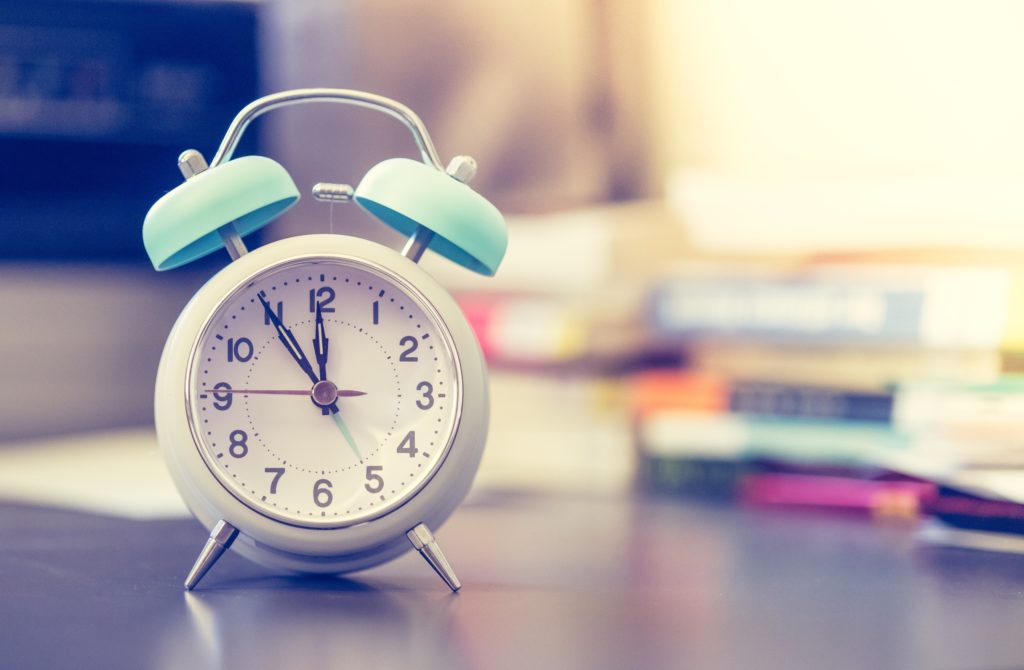
An alarm clock is a small table clock that sets off an alarm at a specific time that is predetermined. Before alarm clocks were widely used, some people would hire a knocker-upper to knock on their door when it was time for them to wake up.
Today, alarm clocks are widely used and can be digital or analog. The alarm clock shown looks similar to a circular wall clock with legs. The large bells at the top ring when a time is set.
Calendar Included
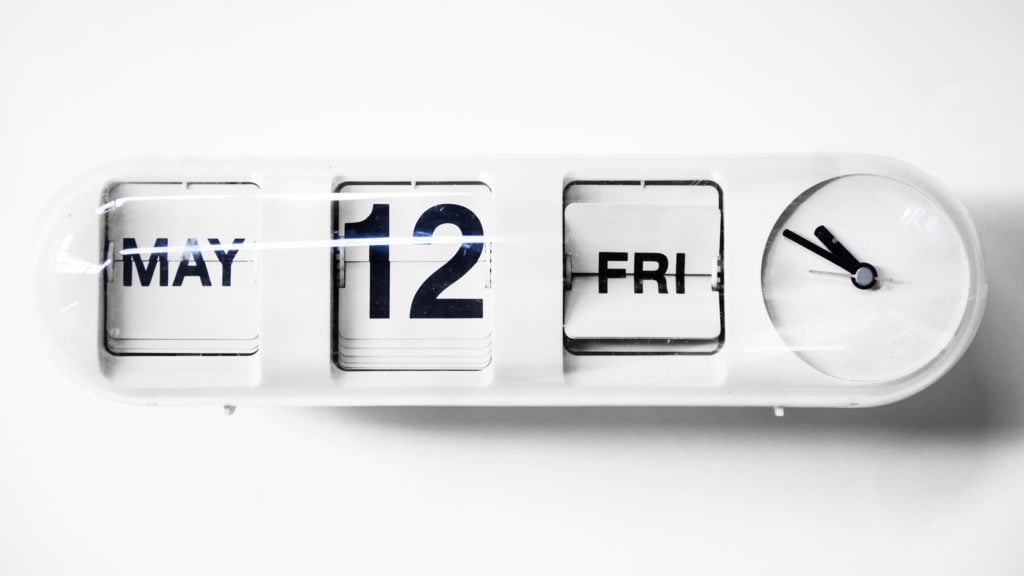
Some clocks are made to include a calendar so that the person viewing the time can also know what day it is. The antique versions have two faces on them. The top told the time, while the bottom face showed what day it is.
The clock shown is a modern version with a calendar on the side. The entire device is rectangular, with the circular face of the clock part on the right. The three-square parts on the left show the month, date, and day.
With Large Display
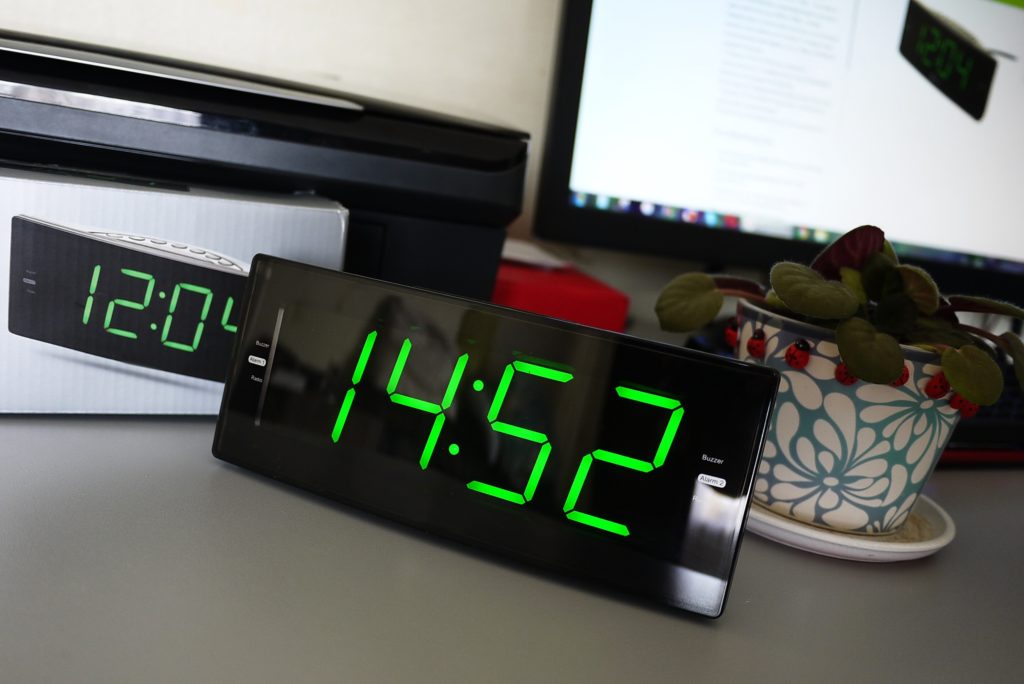
Another type of clock is one with a large display. These are great to use when in a large room and you need to see the time from far away. A timepiece with a large display is also helpful to those who have a hard time seeing smaller clocks.
Large wall clocks are easy to read, as well as digital ones with large numbers. The electronic clock shown has large numbers that light up. It also comes with a radio that is built-in, which is a common feature in many of today’s electrical clocks.
With Light Sensor


A clock with a light sensor can light up at night when needed. Some of these light up once its dark or light up when turned on. These timepieces are digital clocks with large numbers that can be easily read when light shines on them.
The one shown is a digital alarm clock with many features. One of these features is the ability to light up in total darkness. When the sensor light is turned on, a dim backlight helps those that wake up at night to read the time.
Weather Display

A weather display clock can detect the weather from day to day. Many of these are smart devices that can do other tasks, such as display the time and monitor the room temperature.
The digital clock featured comes with many additions. It shows the weather, including if it will rain or snow. Next to the large numbers in the abbreviated day of the week.
Just below this is the month and date, along with the degrees Celsius indoor temperature. Although the clock is basic in appearance, it is very functional and useful.
Non-ticking (Noiseless)


A non-ticking or noiseless clock is great for those who get annoyed at the constant ticking they can hear.
This stylish clock features a mechanism that keeps the seconds hand quiet as it moves along the face of the timepiece. The rustic looks gives it an appearance of clocks from earlier eras, hence the “London 1879” printed on the gray part of the clock’s face.
Binary Clock

A binary clock is a clock that shows the time in binary form. This type of clock shows the hour, minutes, and seconds. Most are in digital form. The binary form is when the numbers are represented by a 0 and 1 only.
The picture shows a binary clock that is digital. Green lights are illuminated on a black background. The binary form of the date is shown at the top, with the hour, minute, and seconds shown under each section below.
Chiming Clock / Striking Clock

A chiming clock makes a “chiming” sound when the time reaches every hour of the day. These are also known as striking clocks.
Chiming clocks were made in Europe during the 12th century when bells were needed to signify a time for the community to pray. The clock would chime for the time it represented. One noise would be made for one o’clock, two for two o’clock, and so on.
The pendulum clock in the photograph is an antique that makes a striking sound for the hour it represents.
Chronometer Watch

A chronometer watch is a timing machine that is a very specific type of clock. Switzerland has a Contrôle Officiel Suisse des Chronomètres (COSC) that certifies their chronometer timepieces as true ones.
The chronometer watch is a highly functional watch that is very accurate in telling time. These watches keep time with an escapement that is made with a spring. Hard stones are used to help the watch keep the right time, such as gold, rubies, and diamonds. The watch in the photograph has stones and elements typical of a chronometer.
Cuckoo Clock
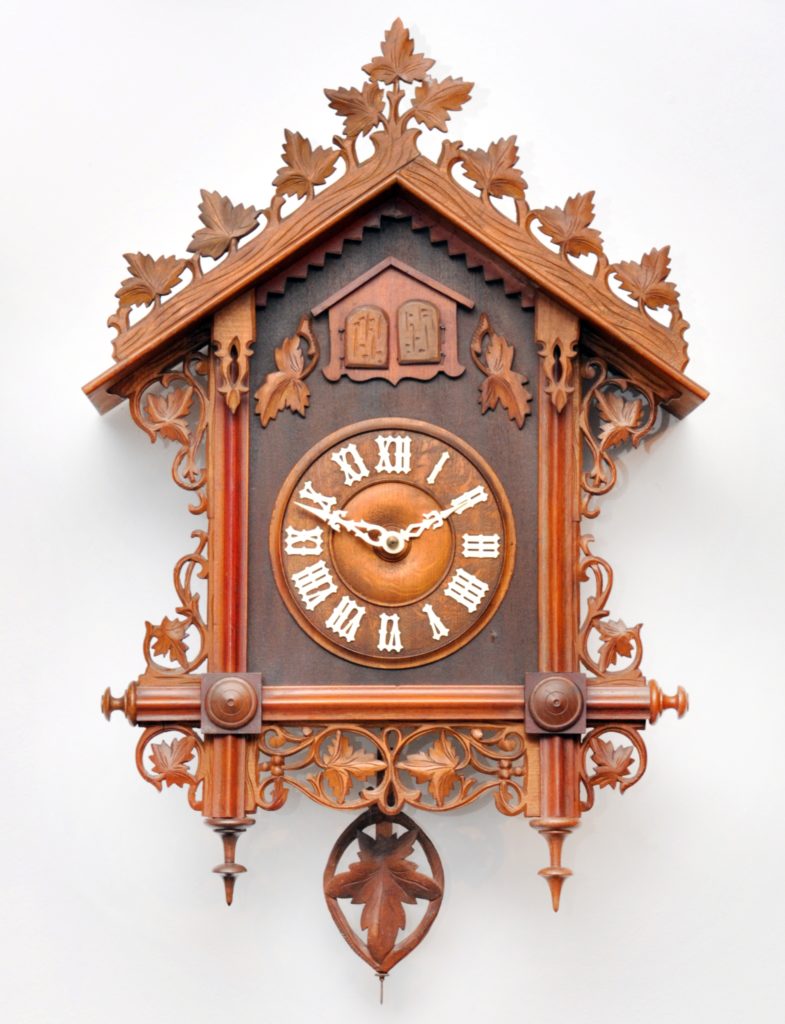
A cuckoo clock is a type of clock with a pendulum that sounds like a cuckoo when each hour strikes. Cuckoo clocks originated from the Black Forest of Germany and were first described in 1629 by a nobleman named Philipp Hainhofer.
Early versions of these clocks had a bird that would move when the clock struck each hour. The one pictured does not show a bird but is beautifully designed with carved leaves and a carved pendulum from the Black Forest.
Equation Clock
An equation clock is one that is mechanical and uses a device that projects the equation of time so that solar time can be read, similar to a sundial. Although more accurate clocks were patented in 1657, people still preferred using sundials for decades.
The equation clock shows solar time and the more accurate clock recently invented. There were several types of equation clocks made. There were ones with and without solar displays, movable minute markings, pendulas, and additional mechanics.
Chess Clock

A chess clock are two clocks that keep time individually. These were first used for players to keep time when playing chess. The opponent would keep time while the other person would make their move.
Chess clocks were first used in a tournament in London in 1883. Now these clocks are used with other board games that use two players, such as shogi, Scrabble, and go.
Master Clock
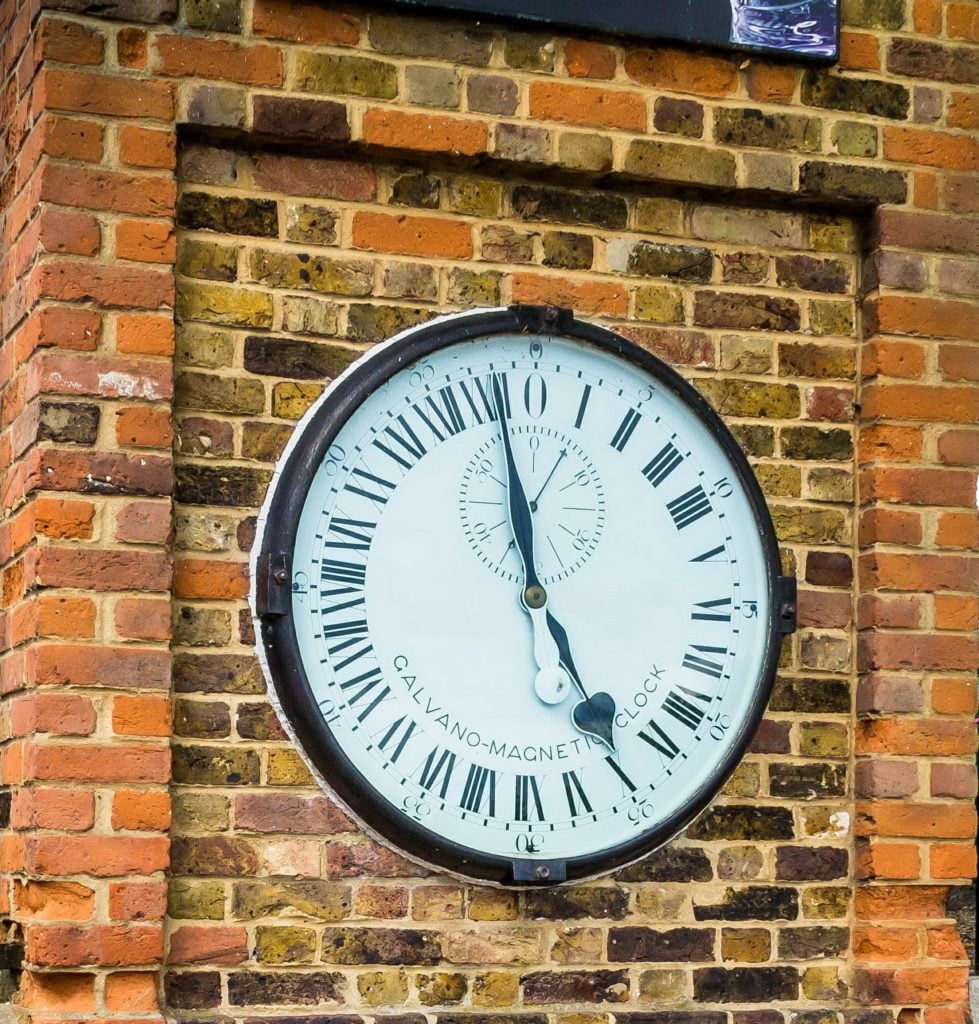
A master clock is an exact clock that gives signals to slave clocks that are grouped together in a timing network. The group of clocks is connected to the master, who keeps time precisely.
Places such as schools, factories, and offices started using master clocks around 1900 to keep all their clock synchronized. When master clocks were first made, they usually had a pendulum to keep time. They looked similar to a longcase clock but had more mechanisms and a plainer-looking case.
Slave Clock
A slave clock is a timepiece that depends on another clock, called a master clock, to keep accurate time. Many clocks today are harmonized with radio time signals or the internet with the Coordinated Universal Time (UTC), which is a worldwide standard of time.
The slave clock is given a signal from the master clock so that it displays the right time. Many of these clocks were used in businesses and public buildings where clocks were needed in many rooms. Schools still use the older type of slave clocks.
Musical Clock


A musical clock is a clock that plays music with movement every hour. This musical clock dates back to 1625 and was made by Samuel Bidermann and his son. Earlier versions were made by Nicholas Vallin in 1598 that can be seen in London’s British Museum.
Mechanical clocks with music use organ pipes, bellows, or a spiked cylinder on wheels. Electrical clocks make music with an electronic sound module. Some clocks move around while playing music each hour, such as the clock above.
Speaking Clock
A speaking clock is a recorded person voice service that gives the correct time over the phone. The first service of this kind was performed in France in 1933, with the help of the Paris Observatory.
At specific time intervals, a voice says the exact time, along with the seconds. Before automated devices, a person would sit and speak the time as it happened. There are countries whose times are sponsored, where the person speaking the time also mentions the sponsor’s name.
Stopwatch
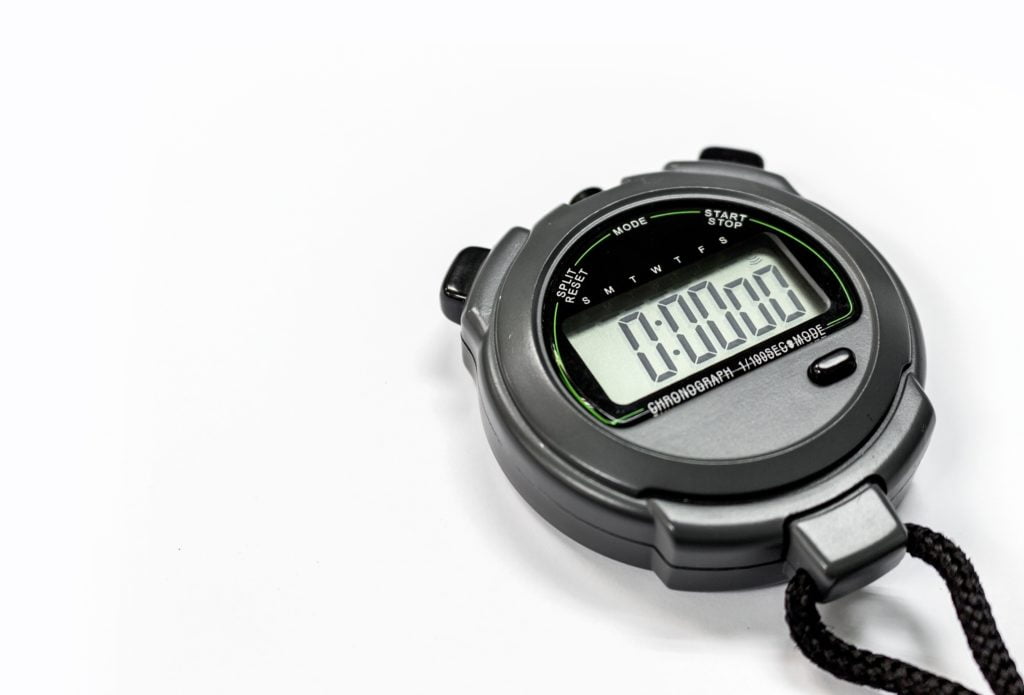
A stopwatch is a clock that is held by the hand and made to measure how much time goes by during a specific activity. Several buttons are at the top to start and stop the time. Another button is available to record lap or split times.
Stopwatches can come in different forms, such as digital, chronograph, and mechanical. The one shown is digital and can be easily held or worn around the neck during use. There is a start/stop button, mode, and split/reset button, among other features.
Talking Clock

A talking clock is a watch or clock that speaks the time out loud. This type of clock is popular with those that cannot see well. Frank Lambert made a machine that recorded the hours in 1878.
There are several variations of talking clocks. Some are made colorful to help children learn to tell the time. They can also help people who are blind to tell the time.
Some table clocks and smartwatches can also speak the time as it happens. Many popular characters have been seen on talking clocks, such as Superman, Mickey Mouse, and Strawberry Shortcake.
Tide Clock
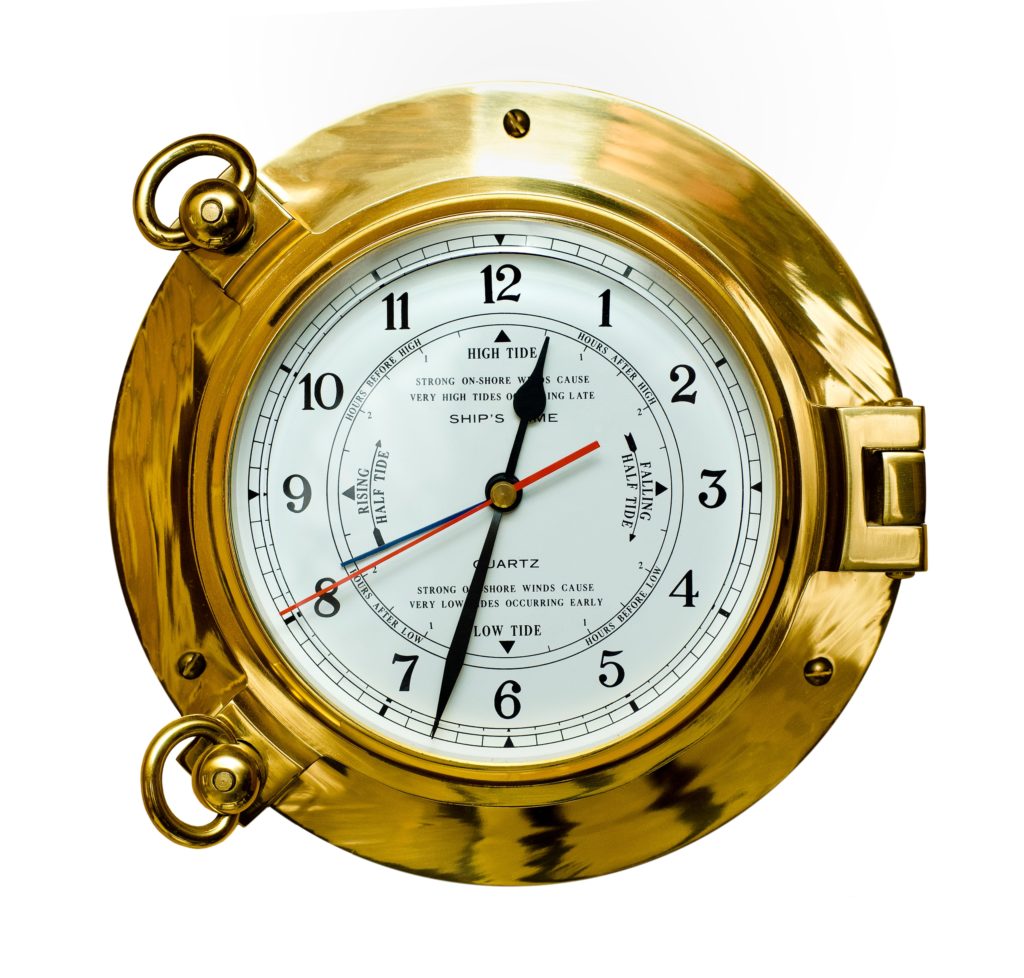
A tide clock is a type of clock that pays close attention to the Moon’s movements around the Earth. Tide clocks keep track of the tides that come and go along with the Moon. There may be a mark for “high tide” and “low tide” as well as other numbers measuring the tide.
Most of these timepieces were mechanical, although now they are in the digital form. Regular tide clocks can measure tides past the Atlantic coast. Smart versions can access all areas around North America.
Time Clock
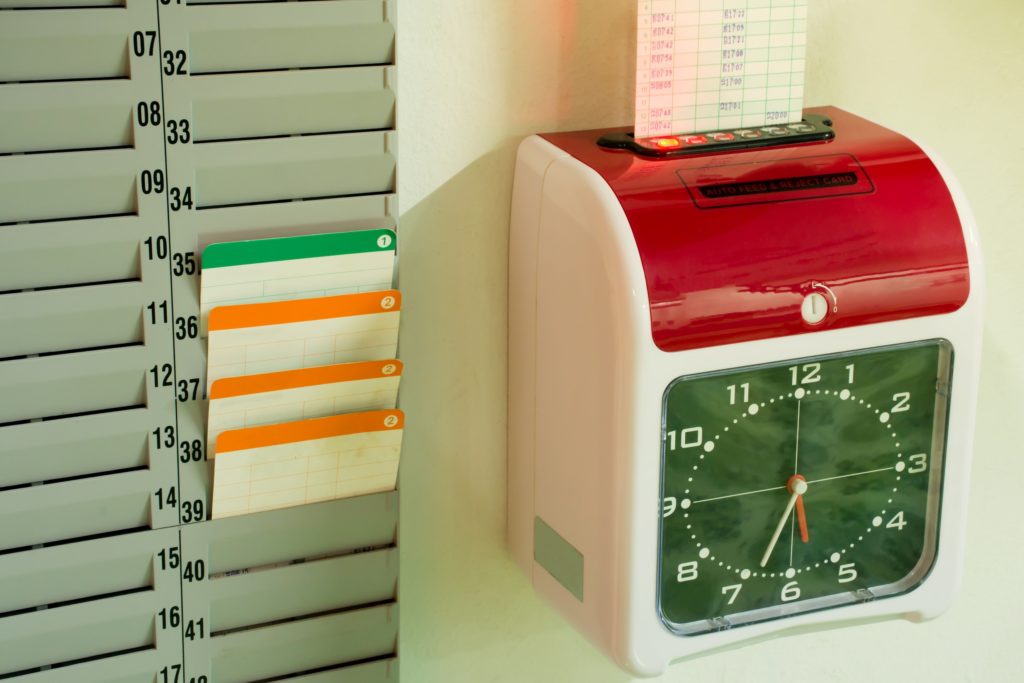
A time clock is a clock used to record the time for people arriving or leaving a job where their pay is based on how many hours they worked that shift. Mechanical time clocks would stamp the time on a heavy time card.
The first-time clock was made in 1988 by Willard Le Grand Bundy, who was a jeweler in Auburn, New York. These clocks are still used but are now electrical. An employee swipes a card with a magnetic strip, that scans in the time and records it electronically.
World Clock
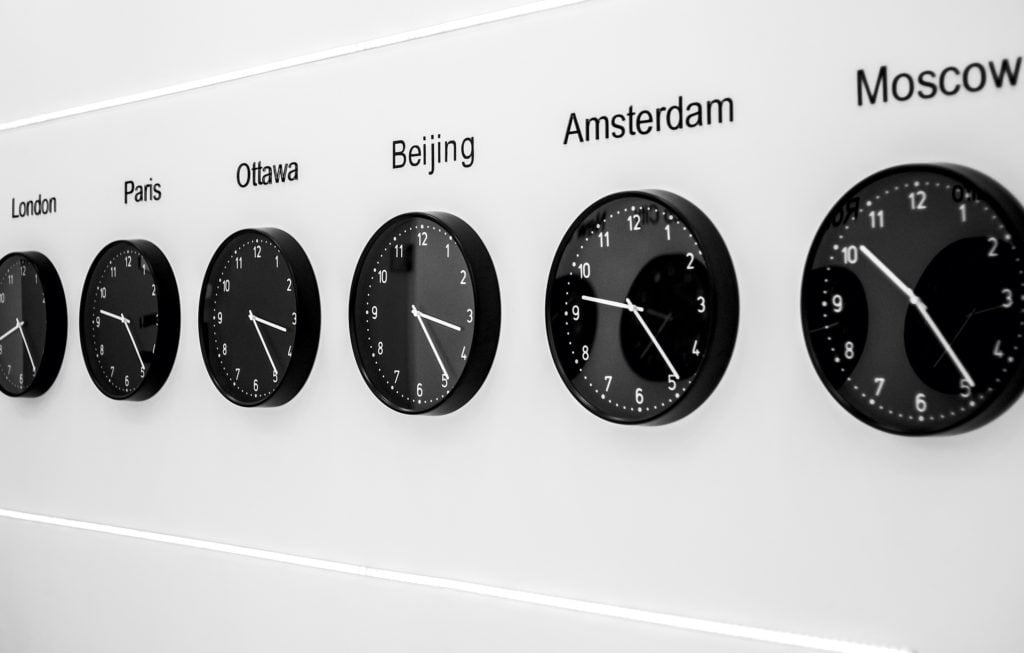
A world clock keeps track of the time all over the world. It usually shows a series of time from different cities around the world.
The world clock in the picture is actually a series of analog clocks featuring the time in several well-known world cities. This type of timing machine can also be a map with digital or analog clocks near the cities featuring the time.
These clocks can also be a world map that moves in a circle, moving around a 24-hour dial ring.
Battery Powered

A battery-powered clock needs a battery to run. Some modern analog and digital clocks need at least one or more AA or AAA batteries to tell the time.
These simple clocks probably just need one battery each. There will be a box on the back of the timepiece near the center, where the mechanics are located. The battery or batteries can be placed there to get the clock working.
Radio Included
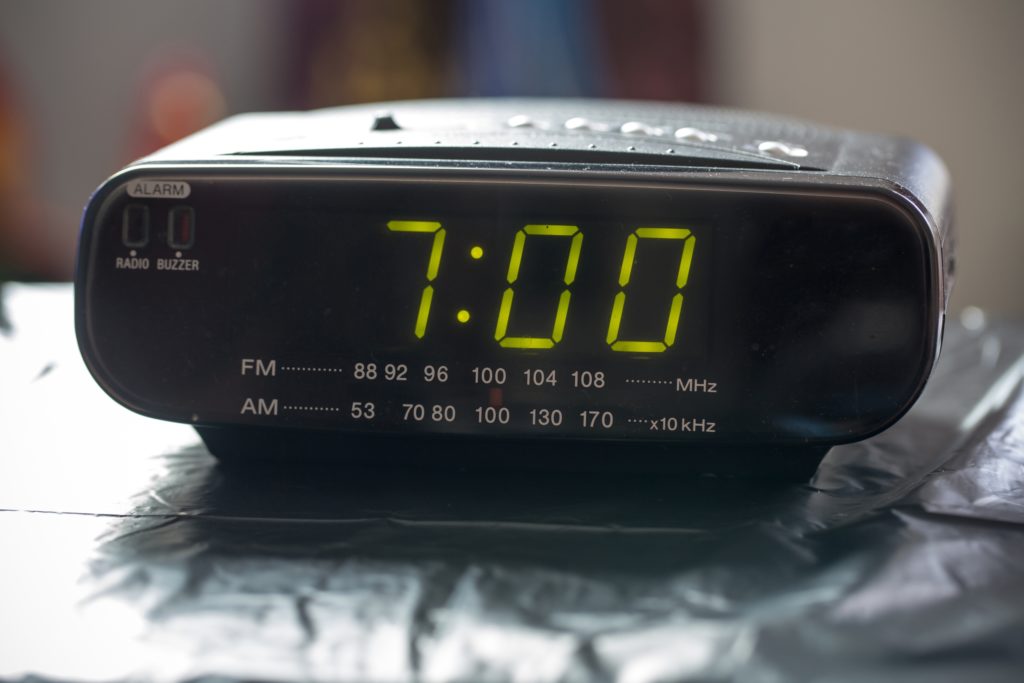
A radio clock is simply a clock that includes a working radio. Many alarm clocks include a radio so that you can wake up to your favorite station, instead of an annoying ringing sound first thing in the morning.
This digital clock can be set to FM or AM stations. There are buttons at the time to switch from the radio to a traditional alarm.
The radio can also be played during the day, for as long as the batteries last. Many also include a cord to plug into the wall.
By Mechanism:
Astronomical Clock
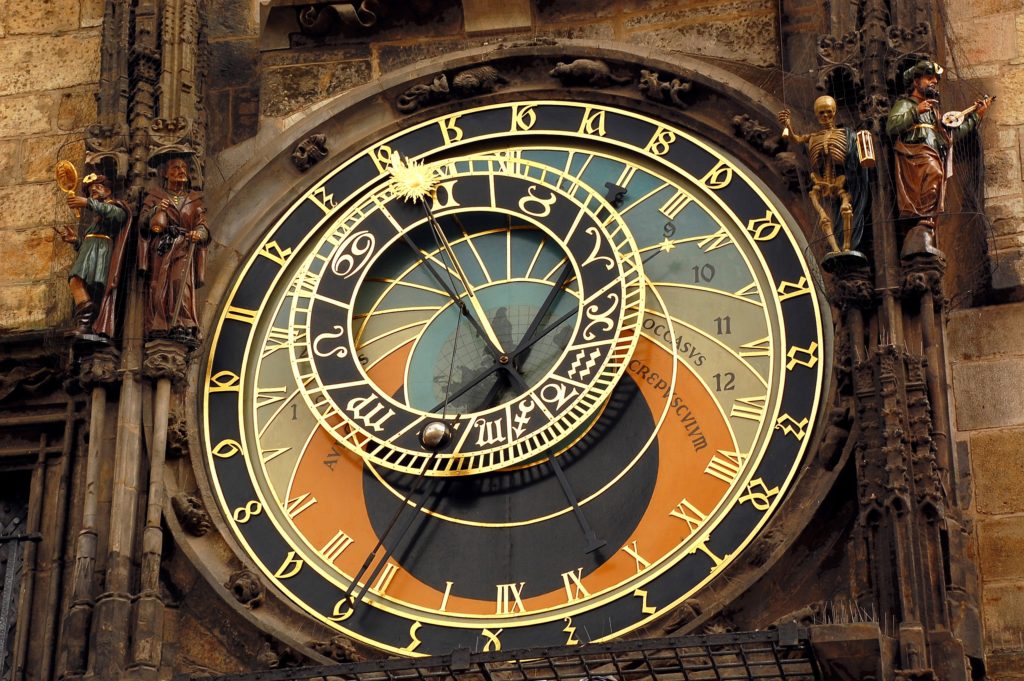
As astronomical clock can tell the positions of the Moon, major planets, the sun, and constellations, as well as the time of day. Many were made by astronomers and mathematicians.
The astronomical clock in Prague was set in the front side of the Old Town Square’s tower in 1410. It was made by Mikuláš of Kadaň. Old Bohemian Time, Babylonian Time, Central European Time, and Star Time can all be read on this clock, among other types of time.
Additions and repairs have been made to keep the clock a central part of the city.
Atomic Clock
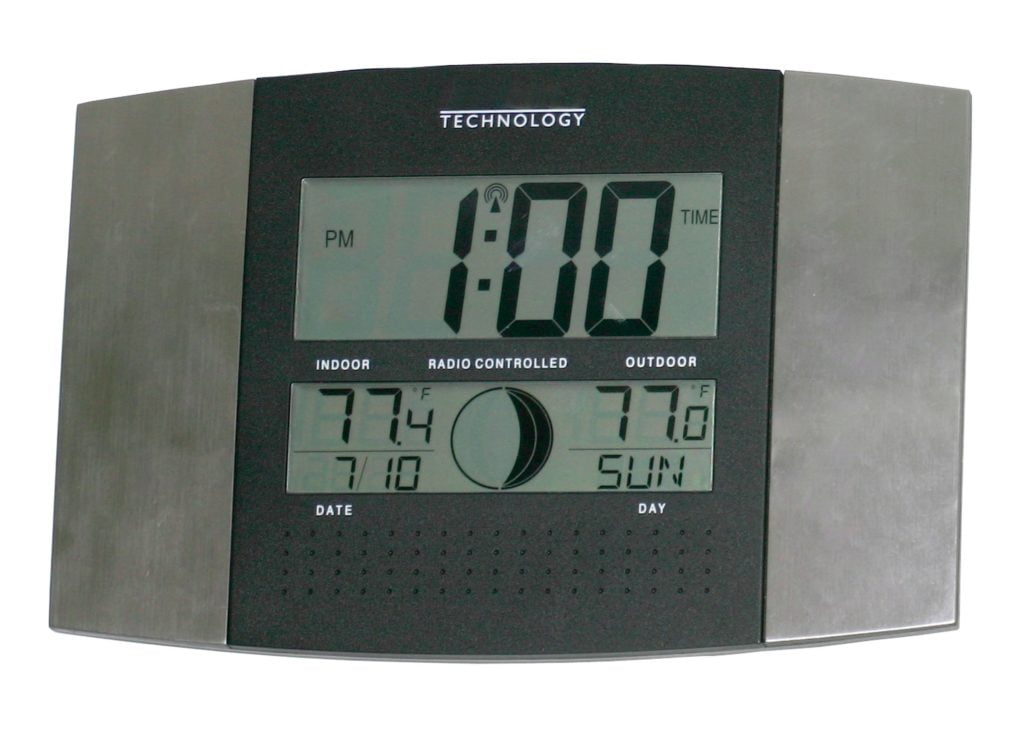
An atomic clock uses a combination of atoms and a quartz crystal oscillator to get a more accurate time. The Deep Space Atomic Clock made by NASA will help satellites be able to assist you with GPS on your phone.
Some are made simpler, such as the one above. This atomic clock and be placed on a wall in the home. It can accurately tell the time, date, temperature, and even the phase of the Moon more accurately than other clocks.
Candle Clock
A candle clock uses a candle to show the passing of time as it burns. These are not used anymore, although they were great to tell time with when it was dark outside.
A Chinese poem first mentioned a candle clock in AD 520. The candle clock mentioned had six candles that were 12 inches high and divided by each inch. The marks burned in 20 minutes, and each candle in four hours.
A more advanced one was made by Al-Jazari in 1206. There was a dial that showed the time and a bayonet fitting.
Digital Clock
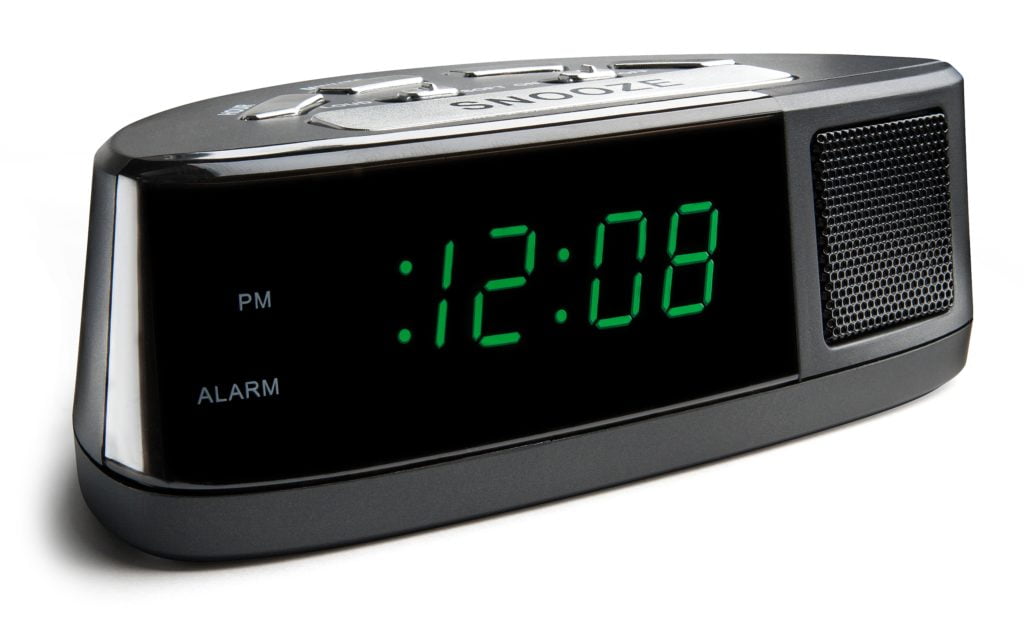
A digital clock displays the time with numbers or symbols, which is the opposite of an analog clock. A digital pocket watch was made in 1883 by Josef Pallweber, and Austrian engineer.
The first digital wristwatch was made that showed an LED display and was produced in large quantities in 1970. Varieties have been made since.
Digital clocks are small and not expensive, making them useful in many settings. People use digital clocks as alarm clocks, clocks in cars, on computers, and ovens.
Analog Clock
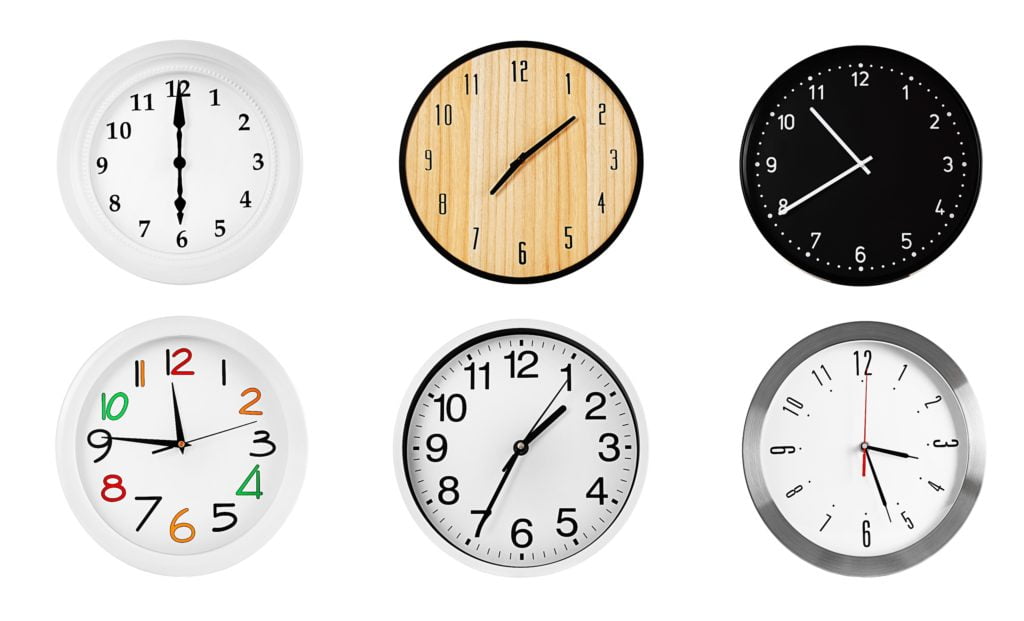
An analog clock has a clock face with “hands” that rotate with points to show the time per hour and minute. The shorter hand is for the hour and the longer hand is for the minute. Some clocks have a second hand for the seconds, which is usually red.
A sundial is considered an analog clock, although those are not as popular today. The analog clocks in the photograph are all made in various designs, but have similar faces with numbers and hands, typical of these kinds of timepieces.
Electric Clock
An electric clock gets its power from electricity. The first of these timed machines were made in 1840. A pendulum and spring were used to create an electrical impulse that would operate several dials. By the 1930s, these were used more than mechanical clocks.
Electricity is used to send impulses to a pendulum, which then turns the clock’s gear train. Once synchronous electric motors were used in clocks in 1918, electric clocks became widely used in homes.
Flip Clock
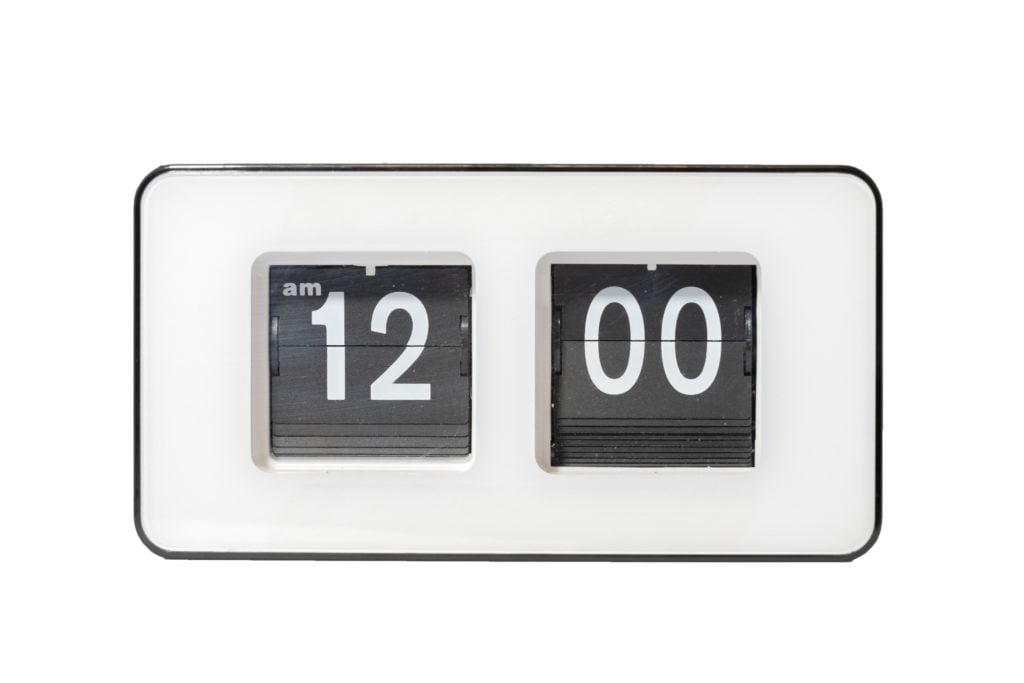
A flip clock is also referred to as a flap clock, because the numbers are displayed with a split-flap. Wheels are used to turn the flaps as time goes on. Vintage ones are not made to use with Daylight savings time, since they cannot be flipped back.
Newer flip clocks can move to the front or back as needed. The flip clock in the picture has a space for the hour and minute, with am or pm on the hours.
Hourglass
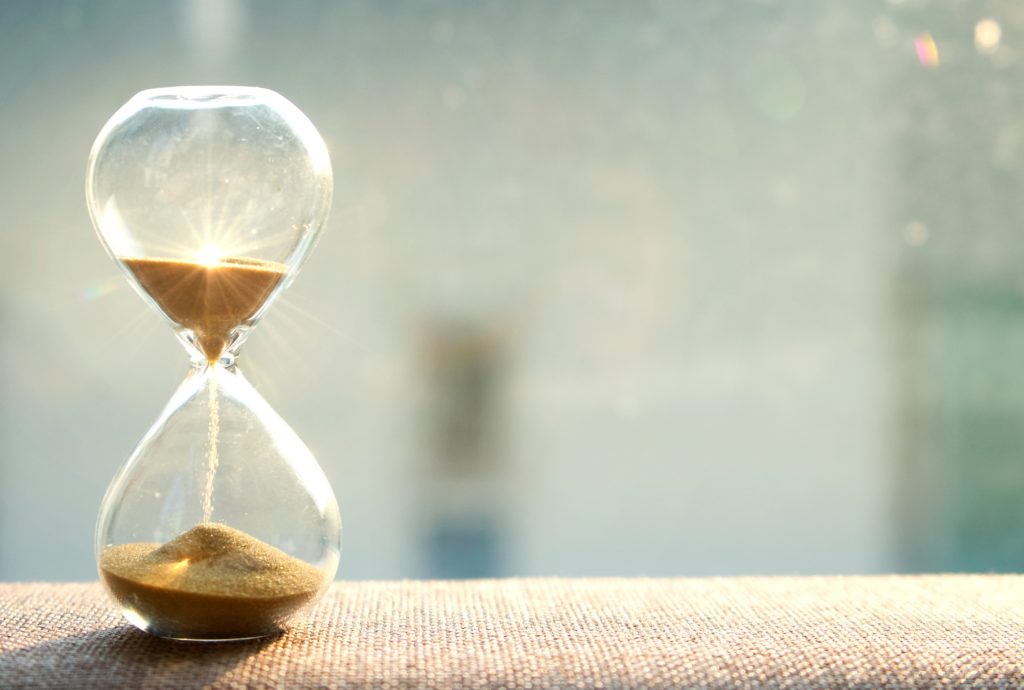
An hourglass is a very early version of a clock. It is also called a sandglass, due to many still using sand to tell time. These can measure a specific period of time, such as a minute or an hour.
These were commonly used on ships to measure how fast the vessel was moving through water. They were also used in churches to keep time.
Hourglasses are still made, although they are now used more as décor pieces or in some games to tell the minutes.
Mechanical Watch

A mechanical watch uses different mechanics to work as a timepiece. The first watches were made in Germany after the year 1500, and were made mainly of iron and then brass. In 1755 Thomas Mudge of England made these watches with a lever escapement, which is still used today.
Jewels were then introduced into mechanical watches in 1704 in London. Sapphires and diamonds were mainly used. The modern watch in the image shows the many mechanics that make up this type of watch.
Pendulum Clock
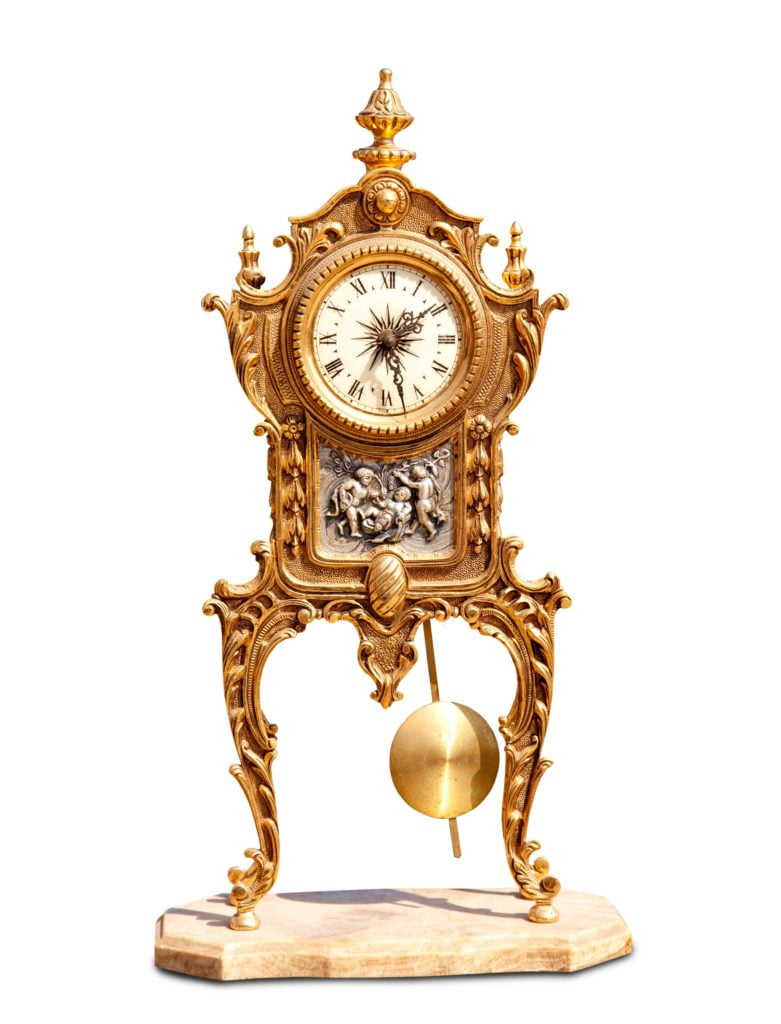
A pendulum clock uses a swinging weight, the pendulum, to keep the time. It was invented in 1656 by Christaan Huygens, a Dutch scientist. It was the most precise timekeeper in the world until the 1930s.
These clocks could be expensive, due to the many ornaments added and material they were made of. The ornate pendulum clock in the photograph has a stylized face set on a golden body. Tiny details have been carved all over, making it a beautiful and functional timepiece.
Projection Clock


A projection clock is also known as a ceiling clock, since the image of the time can be projected onto a ceiling or other flat surface. Analog and digital clocks can both have a projector to make a larger image of the time on another surface.
The first projection clock was patented in 1909, and again in 1940, which have since expired. A backlight is used, such as with an LED or incandescent bulb. They can have a low or high brightness or can be adjusted.
Pulsar Clock
A pulsar clock counts radio pulses that come from pulsars to tell the time. The first pulsar clock in the entire world was placed at St. Catherine’s Church in Gdansk, Poland, in 2011. This clock was the first of its kind, counting time by using a source of signal outside of the Earth.
The clock is made of a radio telescope with 16 antennas, which get signals from six specific pulsars. Another was placed in Brussels, Belgium in the European Parliament.
Quantum Clock
A quantum clock is a timepiece similar to an atomic clock that has laser-cooled ions placed with an electromagnetic ion trap placed together. It was created by a team of physicists in 2010, who said it was 37 times more accurate than the international standard at that time.
Quantum clocks that are aluminum-based keep time with a UV laser that makes ions vibrate at 100,000 times higher than microwave frequencies on other clocks. This makes these time devices more accurate than microwave standards.
Quartz Clock
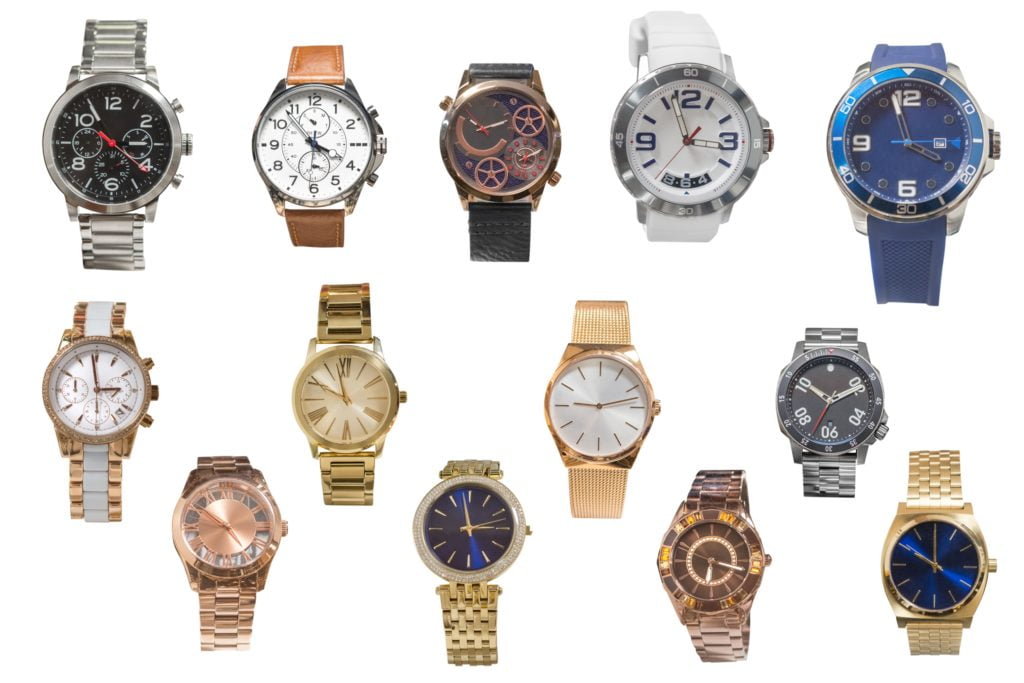
A quartz clock uses a quartz crystal to help keep time. The crystal oscillator makes a signal that has a highly-accurate frequency. This makes these types of timepieces more exact than clocks that are mechanical.
The first quartz clock was made by Warren Marrison and J.W. Horton in 1927 at Bell Telephone Laboratories. The first watch made with quartz was done by Seiko in 1969. All kinds of watches are made of quartz, as seen in the variety shown above.
Radio-controlled Clock
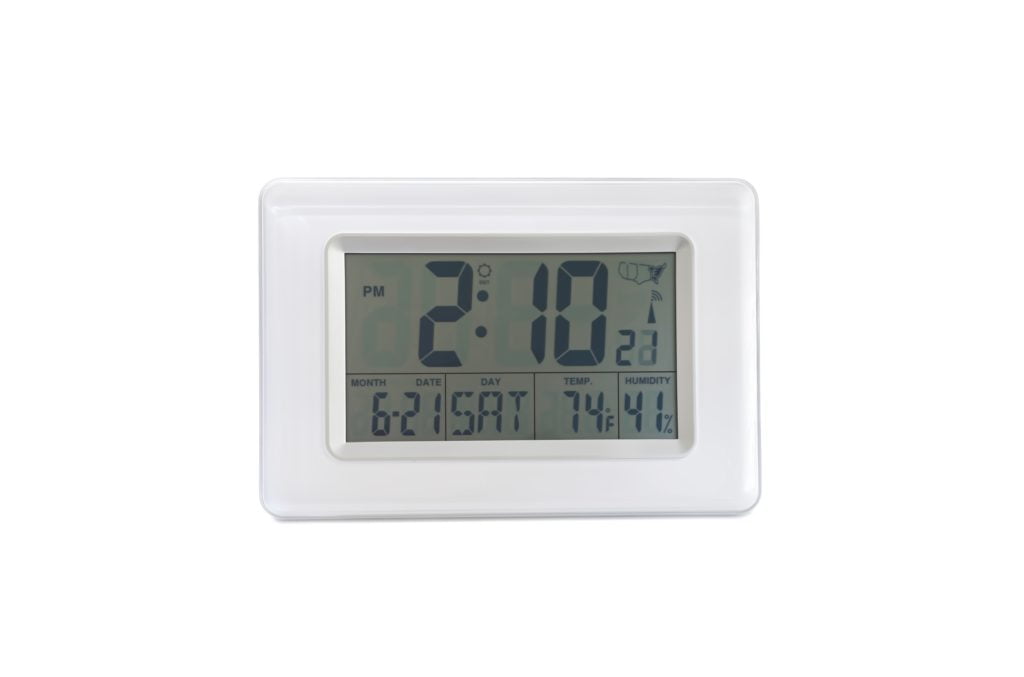
A radio-controlled clock, or radio clock, is a quartz watch has a time code that is sent by a radio transmitter that has a connection to a timed standard, such as an atomic clock. The time on the clock can also be meshed with the time on national or regional time transmitters, or with GPS.
The wall clock on the picture is a radio-controlled clock that features more than just the time. It also shows the region of the country the clock is in, as well as the temperature and date.
Rolling Ball Clock
A rolling ball clock is a machine that keeps time with rails and balls. The Rolling ball clock was invented by Sir William Congreve, who patented the design in 1808. A clockmaker in Edinburgh managed to make one in 1804.
Despite the interesting mechanics, a rolling ball clock does not keep time as accurate as other timepieces. One that was kept at Buckingham Palace would be off by 45 minutes some days. Although not accurate, it would make an interesting decorative piece to show off.
Steam Clock
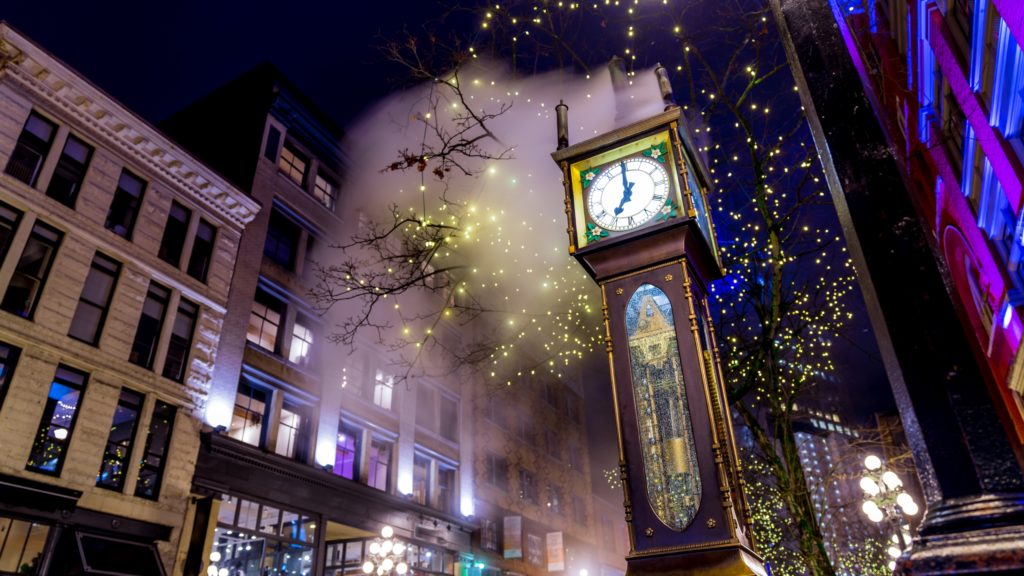
A steam clock is a timekeeper that gets its power from a steam engine. There are a small number of these clocks. Most of them were built by Raymond Saunders, a Canadian horologist.
These clocks look like antiques from the 19th-century, although most were based off a Gastown steam bock built in 1977 by Saunders. This timepiece was built over a steam gate to keep street people from using the area when the weather was cold. The steam is used to power a steam engine that works the clock and whistles to tell the time.
Sundial
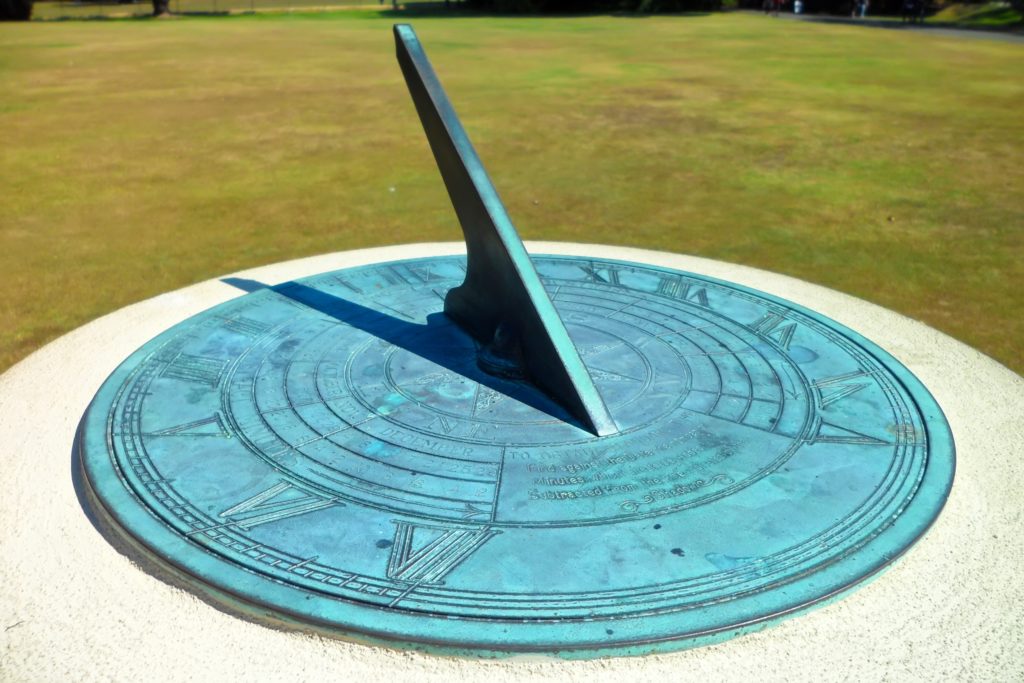
The sundial is the earliest known kind of machine to tell the time. The time of day is shown by the shadow from the gnomon located in the center of the dial. As the sun moves throughout the day, the shadow moves to show the time.
The sundial needs to be placed so that the gnomon is pointing toward the north. The numbers start at one on the right and move clockwise. Sundials are still made today, although most are used as decorations in gardens.
Water Clock

A water clock was called a clepsydra and used flowing water to tell the time back in the ancient days. Natives in North America and some Africans would use a small boat that would go through a hole with water until it sank. These time devices have been found in Egypt from the 14th century BC.
The Romans invented a type where water would drip from a reservoir into a cylinder where a float was placed. The float would be read against a scale kept on the cylinder wall.
By Shape:
Round
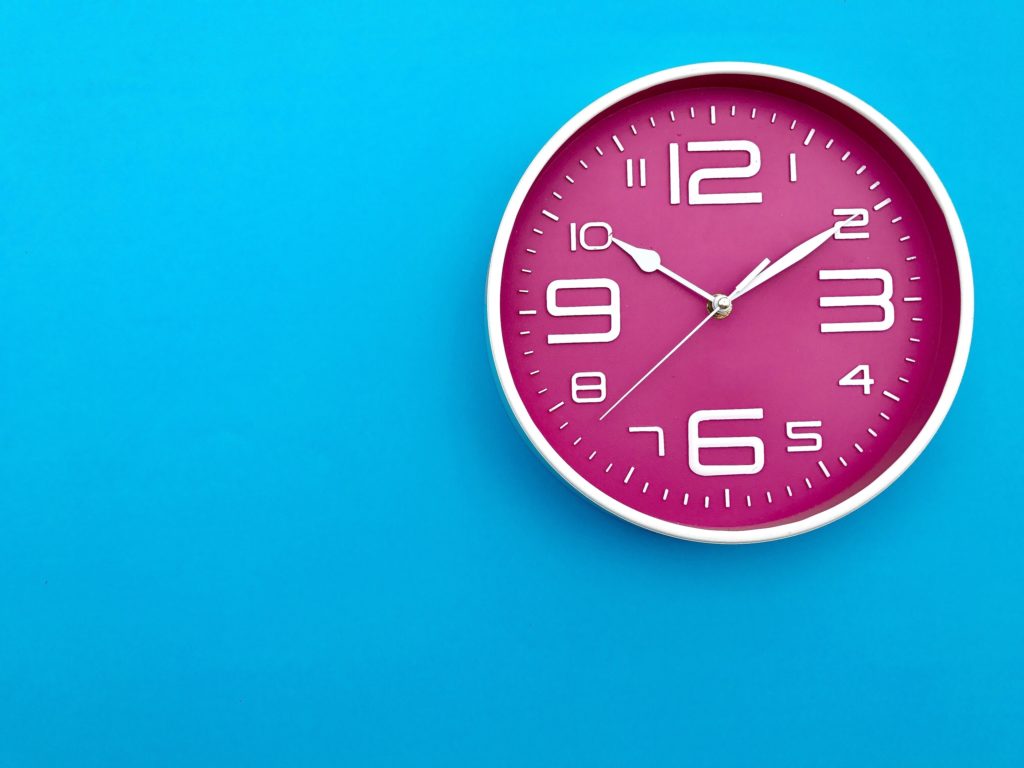
Most clocks are round, although they can come in other shapes as well. Wall clocks and watches are usually round in shape. The round shape helps keep the numbers and time going in a continuous circle.
This wall clock has a pink face with white numbers and pointers that stand out against the darker color in the background. The 12, 3, 6, and 9 are larger than the other numbers, with the minutes indicated by the short, white lines near each number.
Square
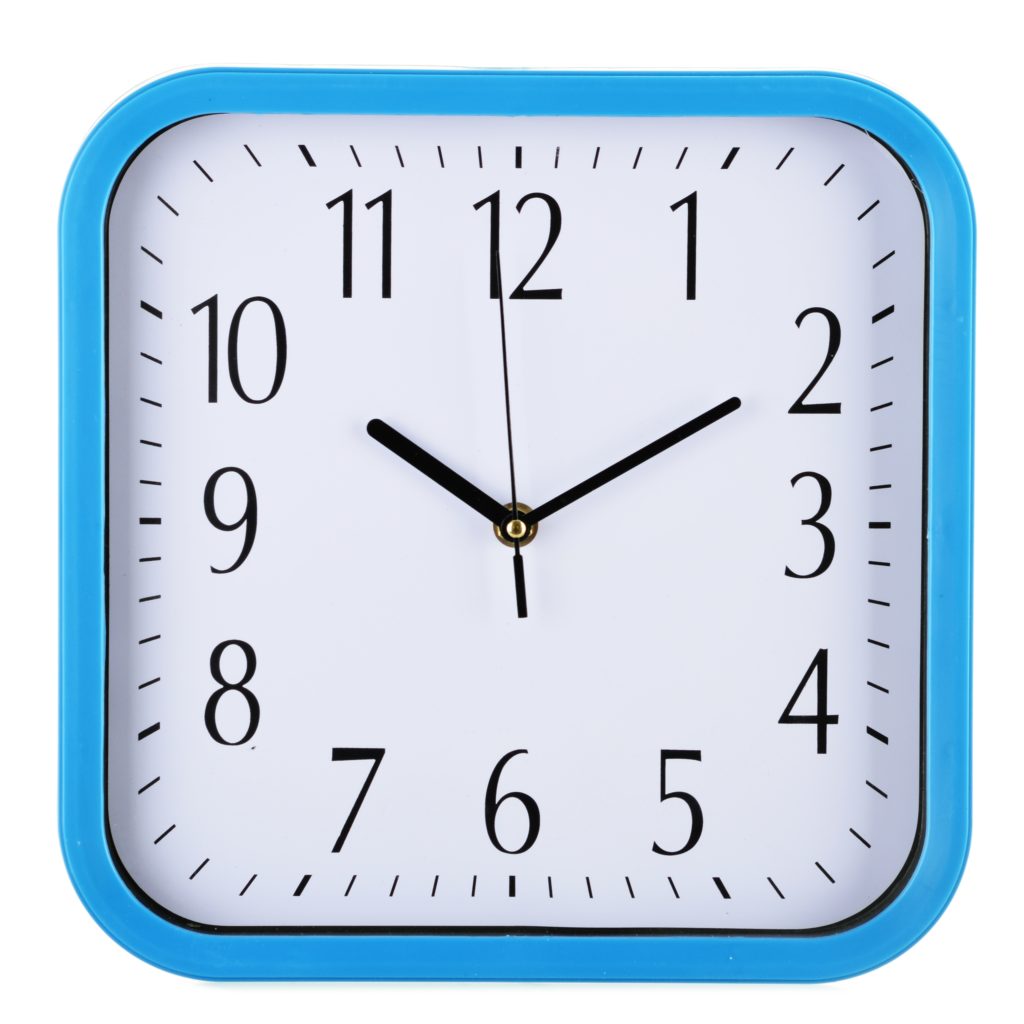
Square clocks are also another common shape for timepieces. Just like round timekeepers square shapes are seen on both watches, wall clocks, and other timing machines.
This wall clock has black numbers that stand out on the white face. The blue plastic around the clock adds some color and design to this simple functioning piece.
The numbers are the same size, with short lines to indicate the minutes. The hour, minute, and second hands are all black, but in different lengths to differentiate between them all.
Rectangle

Rectangle-shaped clocks are an additional common shape to use with clocks. They can be placed horizontally or vertically. A grandfather clock would be considered rectangle-shaped, although the clock part can be round or in another shape.
The face of this art deco clock is in a long rectangle. The numbers are set in rows and columns around the edge. Thin and thick lines on an inner rectangle near the hands indicate the hours and minutes.
Octagon
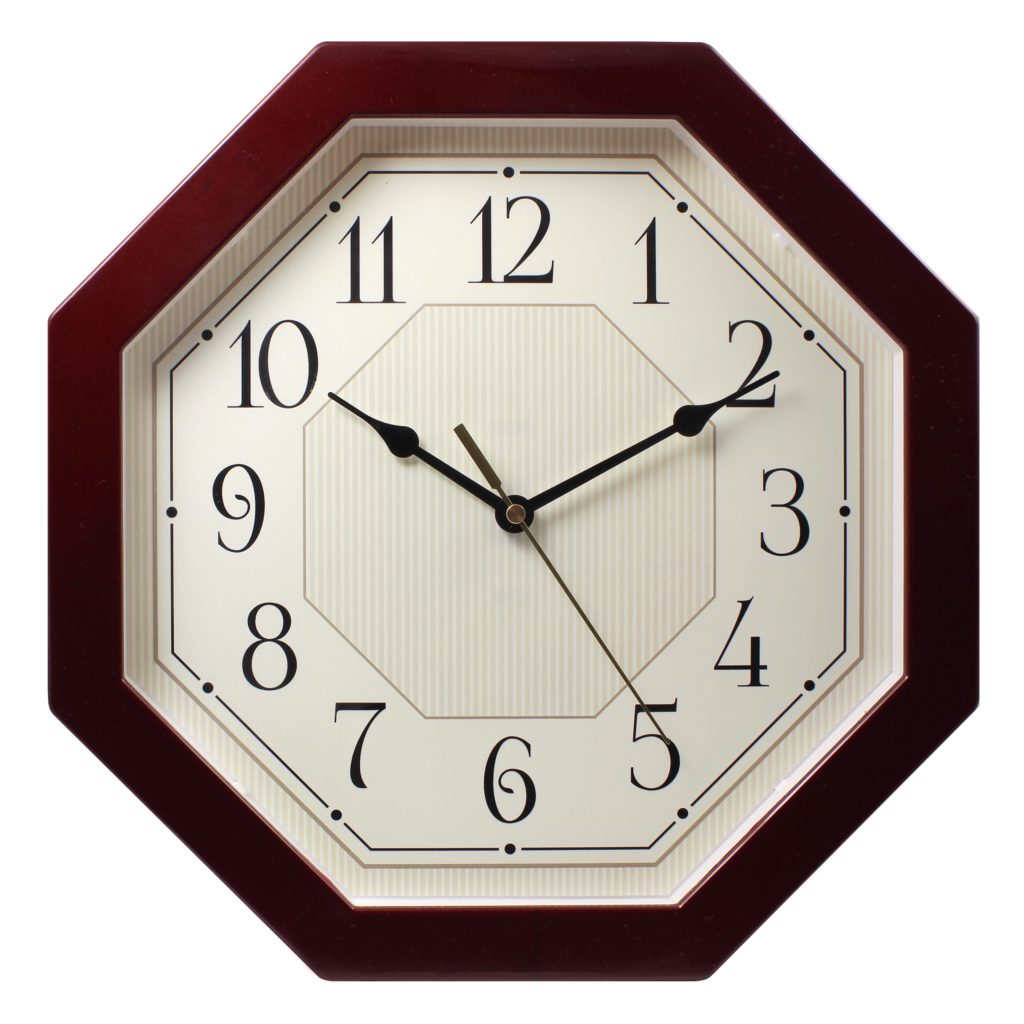
Octagon is a common shape of wall clocks. This octagon-shaped clock is an analog clock with wooden borders.
Novelty


Novelty means something that is new, unusual or original. This robot clock is definitely a newer version of an alarm clock. It would look great in a little boy or girl’s room on the nightstand next to the bed.
Reminders can be placed on the handclips. Its eyes flash to let you know it is time to get up and start your day. This novelty clock also comes in white and yellow.